Your Travel To Marketing adventures await, adding more listings daily. Stay tuned!
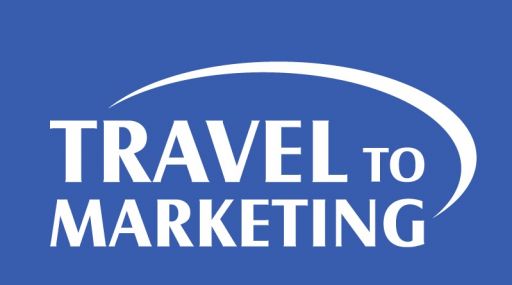
New User Sign-up: Go be cool Forgot Password?


Join our network

Global Travel Marketplace
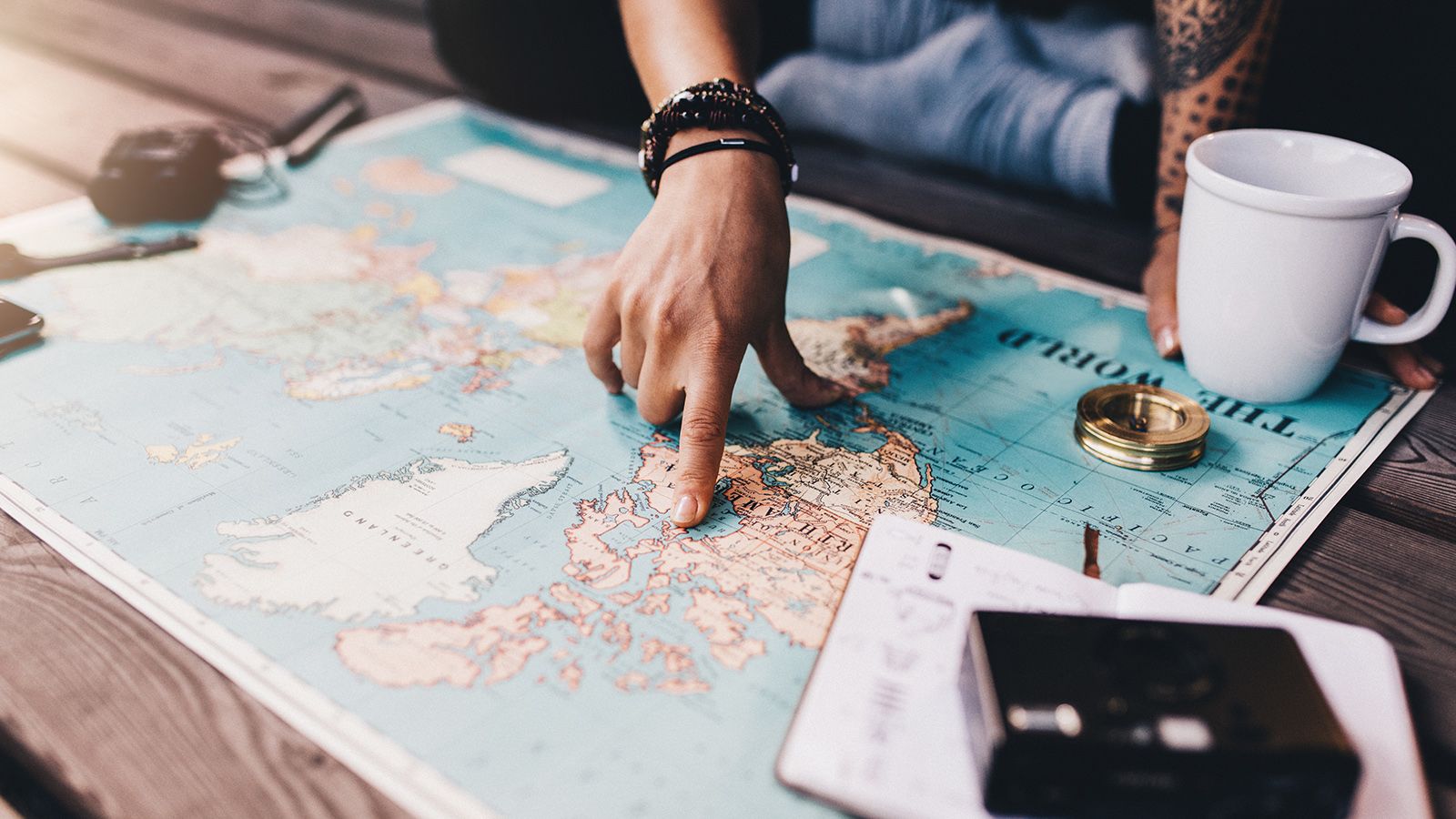
The best DMC's in every destination
Discover our exclusive loyalty programme and increase your benefits..
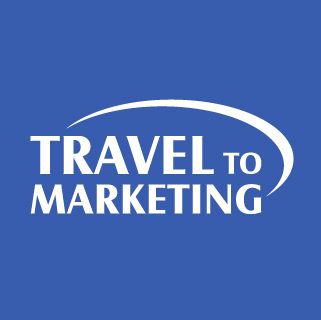
City Packages

Spa and Sport

Tailored Tours
Testimonials.

MIDEAST INTERNATIONAL TOURS
I would like to thank you for all your assistance and for arranging such a nice trip for Mr Cherfan and his family. They enjoyed it very much and spoke highly of your services. Everything was superb!

Rachel Domingo
Aloha Chrismar Travel. I cannot thank you enough for the consistency, reliability, warmth, and just generally excellent customer service we received from your company during every single interaction.

Alexander Ruggeri
We’ve been working together for over 15 years.They helped us diversify our markets and find high end tailor made clients, she’s also put us in touch with large operators.

Joining TTM was the best decision. Now our service offering is known to agents all over the world. Personal attention and continuous advice are fundamental to the development of our business.

Yanir Horowitz
I found out the quality of personal service which is important for me & what I’m working on to give to my clients as one of your best value & of the companies I already had in contact & had business

TTM has become my go-to suite for inbound suppliers in multiple overseas markets. As a boutique agent operating in mid range and high end products, the team of suppliers has always found the right fit

John Karamanis
I have been using Travel to Marketing for over 6 years and have found them to be extremely helpful in assisting our office to research various selling opportunities with the operators

Voula Aikaterini
Happy New Year to all at Travel to Marketing! May it be a year that puts a smile in our face and more funds in our businesses 😊 Thank you for sending the updated list of travel agents/tour
Latest News

Portugal Honeymoon

Toulouse - The multi-faceted region

Amorgos Film Academy

Culinary experience in Japan

- Programmatic Advertising
- Deterministic Targeting
- OTT Attribution
- AI Modeling
Digital Audio
- Digital-Out-of-Home
- Local Sites
- Paid Social
- Paid Search
- Magazine Advertising
- Cover Wraps
- Industry Focus
- Insight Lab

Digital Advertising without Third-Party Cookies

Travel Marketing 101: Everything You Need to Know
People are ready to travel. Where, when, and how varies as much as the individual. Passion, timing, and budgets lead the way. A smart media strategy, combined with evocative storytelling, will transport consumers to your destination.
- What is Travel Marketing?
- Top Travel Industry Trends
Essential Travel and Tourism Marketing Strategies
- — Video Marketing
- — Virtual Reality Experiences
- — Augmented Reality
- — Increase Search Visibility
- — Content Marketing & Native Ads
- — Digital Audio
- — Personalized Messaging
- Big Data in the Travel Industry
Get Started with Travel Marketing Today
What is travel marketing and why is it i mportant.
- The Travel & Tourism market is projected to reach $54 billion in 2023.
- Revenue is expected to show an annual growth rate from 2027 of 4.41%, resulting in a projected market value of over one billion by 2027. 74% of this will be generated by online sales.
It's clear why travel marketing is important. Having a data-driven travel marketing strategy makes all the difference in overall business performance. It promotes travel services to new markets, strengthens awareness of one's brand, and increases the rates of both conversions and sales.
Just as travelers— for business or pleasure—have priorities and purpose in mind, so too should travel and tourism brands. What distinguishes your hotel from the others? What’s unique about your location? Who are your primary targets and how are you going to make their experience exemplary to earn their affinity? It all starts with defining your audience personas, crafting your brand, and knowing your KPIs.
Top Travel Industry Trends (2022–2025)
Again, how and where we travel varies, just as much as the destinations themselves. Below are just a few ways people are traveling. Understanding who is traveling where—and why—will inform strategies and personalization.
- Travelers Go it Alone : 25% of all American millennials plan to travel by themselves each year.
- Travelers Crave Local Experiences : The “experience economy” is huge in the travel industry. Consumers crave authentic experiences that distance them from mainstream tourism.
- Going Virtual : For consumers who want to sample and learn about different places without leaving their homes, there’s the alternative of booking a private tour and activity with locals around the world virtually, and viewing in the metaverse.
- Bucket List Travel: Always wanted to see an Emperor Penguin? There’s a cruise for that. Interested in seeing the beaches of Normandy? There’s a personal tour guide for that. Chances are the journey for these experiences starts with a recommendation from a friend and a good old-fashioned Google search to get the lay of the land.
- Business and Leisure Travel : Working remotely can mean Italy as much as Hoboken. The concept of being location-independent— traveling and working remotely— has become a new mainstay post-pandemic. In turn, digital nomads are searching for locations and deals on where to work and play.
- Sustainable Travel : Most U.S. travelers believe there aren’t enough options when it comes to sustainable travel. Nearly 70% of travelers say they are more likely to book accommodations if they know the property is planet-friendly .
Travel Industry Trends Resources: Generational Marketing 2024 Marketing Trends and Predictions
One of the best travel marketing tips to keep in mind is that most customers are not really paying for products or services in their minds. They are paying for experiences . As with nearly all businesses, technology presents the travel industry with seemingly endless opportunities to connect with customers. Below are just a few way brands are getting noticed:
Video Marketing
In the travel industry, videos have long been an indispensable marketing tool. They show off destinations and hospitality businesses in their full glory. Travel marketers that lean into video creation—and that doesn’t have to equal big budget productions—will forge connections with target audiences. Digital video is an amazing way for brands to educate, elicit emotion, and tell compelling stories.

Virtual Reality Experiences—The Metaverse and You:
It’s the ultimate test vacation. The metaverse can transport you just about anywhere and no passport is required. Like what you see? Post an offer and start planning. While still in the early stages, the tourism industry is already making the jump in the virtual reality (VR) world. Over the past few years, museums have introduced more creative ways to interact with exhibits and some have even taken consumers on pub crawls. Thomas Cook , a pioneer in the travel and tourism industry for more than 170 years, is using 360 VR films so travelers can test the waters of Sharm-el-Sheikh in Egypt and more. And if you’re trying to reach Gen Z, they’re here and they’re ready to go places.

Augmented Reality Enhances Real-World Settings
AR, or augmented reality, differs slightly from virtual reality. AR uses apps and overlays to create an experience and show additions to a particular setting. Travel companies can use this to advantage by using AR to transport and showcase their offerings.
Increase Search Visibility and See Bookings Soar
It’s easy to take the importance of a focused SEO strategy for granted with so many other options vying for your attention, but that would be a mistake. Not having a mindful search strategy as a key tenet in your media strategy would be like not seeing the Eiffel Tower when in Paris. A well-rounded SEO strategy facilitates direct bookings, drives site engagement, and increases overall cost-effectiveness.
Do it right, and you’ll see your Google rankings increase. Getting your brand name on the first page of results is the holy grail to success when 94% of search starts with a search engine and more than 25% click the first result that comes up.
While you may already spend on SEO, it's a good idea to have an SEO check-in from time to time to make sure you’re targeting the right folks and doing so the way they want you to.

Content Marketing and Native Advertising
Few things combine time and place to greater effect than native advertising. It’s the ultimate storytelling device, empowering marketers to say exactly what they want to say and where. A good magazine ad or digital native advertising piece will take the shape of an article—for example, by showcasing a vineyard in Napa on the cover of Travel + Leisure or a video highlighting the beaches of Mexico within a surfing site. The creative will transport viewers, and hopefully a nicely placed call-to-action leads to a website that will give audiences more of the information they seek.
A few native advertising tips:
- Create content that encourages the reader to act
- Know how you’re going to measure results: what is it that you want user to do after they read your article or play your video?
- Try to be original. If you are one of several players trying to host destination weddings, why should they pick you? Are you offering a special incentive code?
- Be authentic. Be real. Native content is storytelling, not overt advertising. It isn't directly selling, per se, but rather sparking ideas.
- Find a fit: Be mindful of where you’re running your creative and complement the space. It’s a curated audience you’re being seen in, so make the most of it.

For many, the first step to a journey is “hey Siri,” "ok Google," or “Alexa,” so it’s little surprise that increasingly travelers (and potential travelers) are turning to devices to book hotels or flights, and learn more about excursions and dining experiences. Markers can optimize content to capitalize on voice searches.
Personalized Messaging Enhances Customer Experience
The goal of effective advertising is to personalize messaging so it's as relevant and beneficial to the recipient as possible. If a travel brand is targeting a young family, it makes sense to highlight the activities for minors. If trying to become a bachelor or bachelorette destination, it may make sense to include in your ad the customized experiences available to enhance their stay (and perhaps a discount code). Leading with a customer-centric perspective distinguishes brands, creates affinity, and earns loyalty.
Data Draws the Big Picture: Big Data in the Travel Industry
The importance of data analytics to drive performance and ROI cannot be overstated and data visualization platforms play an important role in this. They—quite literally—provide a big picture of how all elements in any particular ad campaign are performing. Operators, in turn, can use this information to see what creative is performing strongest, and which platforms are driving the most visit to optimize performance.
Gathering the data enables travel and tourism entities to discern data sets and maximize budgets. Data visualization platforms, such as MNI’s industry-praised Optics , gives advertisers the ability to evaluate key metrics and optimize ROI.
- Engagement rate: How are people engaging with your content? Are they commenting, saving, and sharing, or merely scrolling past? If you have a million followers but only 1,000 interact with your marketing, that is not a great return on your effort.
- Targeting/Retargeting: Are your ads reaching new audiences and are you using data to re-engage potential leads or customers who leave your website without converting? Retargeting ads are designed to help advertisers reach visitors who do not convert right away. These campaigns are effective because they allow advertisers to target engaged customers with a highly relevant ad. Retargeting delivers strong results for increased awareness, website traffic, and conversion rate.
- Putting it all together: Let the picture of what you see tell you where you want to go, where you should be spending more, what ads you should optimize. For the effort that your business is putting into collecting and maintaining a database, you should be able to obtain an equal or greater amount of value from the insights it gathers.
Attitudes to travel are a moving target. Whether traveling for business or leisure, going by air or train or car, the desire to travel is real. Telling your target audience how you will be providing value and keeping them safe is essential. Step #1, know your audience. Step #2, connect with them. Step #3, embrace a multi-channel strategy. To do this, it’s incumbent to keep up to date with the very latest travel marketing strategies and to partner with those that do it best.


Travel Marketing Best Practices: How To Apply The 7P’s To Make Your Travel Business More Successful
Understanding the crux of the 7Ps of marketing is pertinent for you as a tour operator. It can help you analyze your competitive strategies, capitalize on key elements of marketing to attract new customers and ultimately reach your sales targets.
The marketing mix involves various processes, each one focusing on different areas of your marketing strategy. These different processes all need to work together in order for you to successfully attract and generate new customers.
In this guide, we’ll break down the 7s of marketing and cover some of the most important travel marketing best practices to keep in mind with each of these different areas.

The 7Ps of Marketing for Travel Businesses
The beauty of the marketing mix is that it helps you to set objectives and create a clear roadmap for your business to promote itself in the market. This includes the different marketing channels and tactics that are applied.
In 1960, professor Jerome McCarthy first proposed the idea of the 4Ps of marketing - which refers to the four elements that make up a traditional marketing mix. This applies to any kind of business. The 4Ps are
However, strategies in marketing have changed tremendously since then, and the way different types of businesses reach customers varies. This resulted in the 4Ps evolving. It only made sense to add additional Ps to accommodate all industries. These Ps include
- Physical Evidence
The 7Ps can help you attract your target audience more easily and provide the right kind of marketing messages and value to turn those prospects into paying customers.
Let’s break down the 7Ps of travel marketing.
1. Product
First, there’s your product. This refers to what you’re selling your customers, and it’s what your entire travel marketing strategy will be centered around.
For many traditional businesses, a product is a physical item that you can place in your basket, or buy online and unwrap at home. However, in the travel industry, your product is not tangible. For travel businesses, product refers to some kind of tour, service, or travel experience.

When it comes to travel marketing best practices, you must understand how your product fits into the market, and what type of demand there is for your product. You’ll also need to know the unique selling proposition (USP) behind your product, and what will motivate a customer to make a purchase (or, book a tour).
There are typically a lot more factors involved in the purchase decision process for travel products. For example, a travel business customer will need to
- Plan their trip around what free time they have available
- Plan their trip around the weather
- Purchase without understanding the direct effect, or benefits, the travel purchase will offer them
- Travel purchase decisions often involve a fairly large investment, without getting a tangible product in return
This means there’s a lot to keep in mind when marketing your travel product to your audience. Understanding the market conditions, the competition, and what makes your product special is essential for attracting and retaining customers.
Of course, you also need to offer a high-quality travel product if you want to make a lot of sales.
Some travel marketing best practices include sharing as many details about your products as possible on your website, sharing videos and images of your travel experiences on social media, and showcasing reviews and testimonials from past customers.
2. Place
Place is an element of the marketing mix that refers to where and how you make your product available. Because your travel product is intangible, you will likely be selling it online (as opposed to a shelf in a shop). You could also be selling through a booking platform, an OTA , or a travel desk.

Whatever the case, travel marketing best practices here involve making sure that the place you sell your product offers a smooth customer journey. This means providing a booking process that is easy and secure, and that includes all of the information your customers could possibly want to know.
For example, your website should include detailed booking pages for each of its travel experiences, with an easy and secure payment gateway. This is easy to apply with travel booking tools like WeTravel . The right booking platform will reduce friction in the customer journey, helping you sell more tours.
3. Price
The price of your product, or tour, is arguably the most important factor in your travel marketing mix. You need to price your tours strategically in order to make enough profit, be competitive in the market, and attract enough bookings.
First, you’ll need to understand the market and the competition to understand the costs of other tours in your area.
Second, you’ll need to align your pricing strategy to the USP and value your tour offers. It’s important to relate price to value. This is because customers will be willing to pay more for a travel experience if it is justifiable, and the extra money relates to extra value.
If you offer the same experience as the competition but charge more, then your tours will seem unappealing. If you offer added value to your travel experience, then you can get away with charging more. You’ll also be able to use this added value as your USP.

Of course, you also need to cover your overhead costs and make sure that your pricing strategy makes sense for your travel business.
How much you charge for your travel products determines how your business will fit into the market, so it's important to have a full understanding of your financial situation in order to price appropriately.
4. Promotion
This element of the marketing mix is all about how you promote your travel business to your target audience. Travel advertising includes a lot of key tactics, so, you should choose ones that best align with your target audience and overall marketing goals.
When it comes to travel marketing best practices, it’s recommended that you utilize a wide range of marketing channels and processes. This could include:
- Email marketing
- Social media marketing
- SEO and content marketing
- Paid advertising
- Physical marketing (flyers, posters, etc)
It is also essential that you have an optimized website , as this is where you will direct all of your marketing efforts to generate bookings.
Whatever tactics you use to promote your travel business, you need to make sure that they align with your customer journey and with the behavior patterns of your target audience/buyer persona.
This means using marketing channels that your target audience routinely uses, and promoting the right messages and content on these channels to appeal to your viewership.
Of course, you’ll need to keep your USP and market positioning in mind when running your travel advertising campaigns. Use your promotional efforts to stand apart from the competition and strategically communicate why customers should book your tours and what kind of value they would get in return.
You can check out our guide to creating a travel business inbound marketing strategy for more tips and tactics.

5. People
Who represents your business? This is incredibly important for travel marketing, as your products are closely linked and associated with the people who deliver them.
If you sell a product like a toothbrush, customers wouldn’t care much about who is behind the toothbrush. However, if you’re offering a guided tour through the Andes, then the person providing the tour is an essential factor in understanding whether the tour is worth purchasing.
This means that people are a factor in your travel marketing mix that you need to carefully consider and promote.
In terms of travel marketing best practices, anyone who comes into contact with a customer and represents your business must maintain a certain standard of friendliness and professionalism. The people behind your business play a major role in shaping the customer journey and influencing their purchase decision.
It’s also a good idea to display your credentials and experience on your website or booking pages. Use the people in your travel business to offer more value to your customers.
For example, you could highlight the fact that all of your tour guides are trained in first aid safety, or that they are experts on the local flora and fauna. This gives your tours a competitive edge and gives customers more reason to book your tours and helps them develop more trust in your travel business.
6. Processes
Process is one of the unique “P’s” of marketing for travel businesses. This refers to the journey, or processes, that a customer goes through from when they book your tour to when they complete it. Your goal is to make these processes as enjoyable as possible for the customer.

Make sure that you offer customers all of the information they need at any given stage of their journey. You also want to ensure that your customers can easily communicate with your business when needed.
Some useful tactics involve sending automated consummation messages after a customer makes a booking, and sending the customer a pack of relevant information before the tour. All of their booking information, itinerary, waivers, and anything else, should be easily accessible.
When optimizing the processes in your marketing mix, it's also important to consider efficiency for your business. Your aim should be to plan out a strategy that is reliable, scalable, and efficient.
Using the right travel booking system is essential as it will help to provide a smooth journey for both your customers as well as for your business.
7. Physical Evidence
This is the final element of the travel marketing mix. Physical evidence can seem tricky because travel experiences are largely intangible. This means it can be difficult for your customers to look into the physical evidence of your travel experiences before making a booking.
However, carefully presenting any physical details about your business or topics will play an important role. Keep your vehicles clean and well maintained, make sure your staff are well-presented, and carefully maintain your storefront if you have one. These elements all help to build trust.
You can also use your website to help you provide physical evidence around your tours. Make sure your website is modern, trustworthy, and functional.

You should also try to incorporate a lot of images and videos of your travel experiences into your booking pages, to help customers gain an idea of what these experiences look like.
Stay Ahead of Travel Marketing Best Practices
Staying ahead of travel marketing best practices can be tricky because the industry is constantly changing. As technology develops and customer journeys change, so do the marketing tactics and strategies you use to attract new customers.
That is why it's important to stay ahead of industry trends with a reliable and trusted platform.
A key resource in this regard is WeTravel Academy . The sole focus of this resource is to create a valuable “database” (so to speak) to help all the professionals in the travel industry with a wide range of focus areas. This may include group and multi-day travel, international tour operators, other trip leaders, wellness, and retreats.
You can freely access a wide range of e-books, webinars, courses, and articles to help you stay ahead of industry best practices and grow as a professional and tour business.
Conclusion
Understanding the key elements of a travel industry marketing mix is important for being able to develop a well-rounded marketing strategy.
You need to understand and address all of the different factors involved in the customer journey and decision-making process in order for you to be successful at marketing your travel company.
The travel marketing best practices above should help you lay the foundation. Of course, you’ll also need to be set up with the right travel software and tools to help you seamlessly implement these different areas of the travel marketing mix.
New resources, straight to your inbox
We’re committed to your privacy. WeTravel uses the information you provide to us to contact you about our relevant content, products, and services. You may unsubscribe at any time.
About the author

Related Posts
7 travel marketing ideas to sell more spaces on your religious tour, 7 content marketing mistakes that small travel businesses make, what is inbound marketing and how can you start applying it to your travel business .

Request a Proposal
Fill out the contact form and one of our strategists will reach out to you via email to schedule a short phone call consultation to discuss your business.
Drop Us a Line
Let’s Craft Your Campaign
- Full Name *
- Email Address *
- Company Name *
- Company Website *
- Digital Strategy
- Performance Media
- Full Funnel Network
- Organic Social
- Media Creative
- Anything else you'd like us to know?
12 Travel Marketing Strategies To Help You Out-Market Your Competitors in 2023
Kyle Morley
January 26, 2023

The world of travel has evolved, especially after the COVID-19 pandemic in 2020. Travelers are valuing their time off more and researching more heavily before making travel decisions. Additionally, brands are competing to drive bookings and increase revenue to make up for the large losses the industry took in 2020.
Utilizing new and unique marketing strategies can help travel brands separate themselves from the competition, reach new audiences, and increase bookings. Take a look at our top 12 marketing strategies that can help travel brands stand out and out-market their competitors.
What Is The State of the Travel Marketing Industry in 2023?
The travel industry took a huge hit in 2020 with the emergence of the global COVID-19 pandemic. Both domestic and international travel stopped almost overnight, leaving the travel and tourism industry with little-to-no business. However, over the past three years, the industry has steadily increased to semi-regular rates, though still slightly lower than 2019.
According to the International Air Transport Association , global air travel is expected to make a full recovery by 2024. Additionally, the IATA expects domestic air travel to increase by 3% in 2023 compared to pre-pandemic levels in 2019. With that being said, many travel companies are looking to dedicate time and resources to out-marketing their top competitors and return business to pre-pandemic levels.
12 Travel Marketing Strategies For 2023
Using a combination of tried-and-true marketing strategies and unique ideas will offer a fresh foundation for travel destinations to attract new tourists and increase bookings. In 2023, the way consumers make travel decisions has changes. People are valuing sustainable travel options and relying heavily on social media and video content to make their travel decisions.
Luckily, we’ve compiled a list of 12 key marketing strategies and tips to help travel companies increase bookings and drive consumers to their destination.
1. Create A Seamless Website Experience
All of your marketing channels will be driving traffic to the same place – your website. If the user experience is lacking, it could drive away potential customers or have them book a stay with a separate OTA.
As direct bookings become increasingly important for travel companies, a seamless user experience on the website is of the utmost importance. A travel website should showcase all of the best things about the destination to really show consumers what their vacation will be like. Additionally, users should be able to seamlessly book travel experiences directly from the site.
2. Publish Blog Content on a Regular Basis
Blog content is a great way to capture the attention of untapped audiences and focus on search engine optimization. By creating content that targets highly searched keywords in the travel space and keywords specific to your destination, brands can dominate the search engine results page.
Not only does long-form editorial content help put a brand in front of new audiences, it also showcases the beauty of your travel destination. Consumers want to learn a lot about a destination before traveling there. According to TripAdvisor , consumers will spend an average of four weeks researching their travel destination. With blog content, brands can create a high quality resource for consumers to turn to throughout their research process.
3. Lean On Your Customer Reviews
Consumers are spending more on travel now than ever before. According to the ASTA , 40% of consumers are spending more on travel now than they did before the pandemic in 2019. However, consumers also want to be sure that their money is being spent in the right place.
Traveler reviews are some of the most valuable pieces of content that brands can use in advertising. Sites like TripAdvisor and Yelp are growing increasingly popular and can make or break a travel destination. By showcasing positive experiences that other travelers have had, brands can increase social proof and gain trust with new customers.
4. Upgrade Your Social Media Game
Social media is an integral part of any marketing strategy for 2023 and beyond. With the growing popularity of platforms like TikTok and Instagram, travel companies can leverage their social media following to increase bookings and drive traffic to other marketing channels. Regularly posting content and engaging with your audience is incredibly valuable for companies in the travel industry.
Influencers are also a key part of a social media marketing strategy. Utilizing influencer content allows you to reach completely new audiences and showcase the best parts about your brand and vacation destination. If you are looking to increase your reach with photo and video content, social media marketing is the best way to do so.
5. Rely On Data for Key Insights
Data is everywhere – you just need to know how to track it properly. Between websites, social media, online advertisements, and more, there is an abundance of consumer data that can be used to optimize your marketing strategy.
Travel companies can track user behavior, see where high-converting consumers are coming from, and see what marketing strategies are currently working. Using this data to further improve and optimize your marketing efforts will provide unbeatable insights and deliver quality results. However, you need to be confident that the data you are using is trustworthy and accurate.
6. Don’t Underestimate the Power of Remarketing
Remarketing is a powerful tool that can help direct audiences to your travel website or destination. A customer journey, especially in the travel space, can include tons of different searches and websites.
Remarketing may prove to be one of the most valuable tools in your marketing toolbelt. When consumers are more familiar with your brand, they may be more receptive to advertisements. Additionally, consumers may be more likely to convert after visiting your website more than once.
7. Improve Your Mobile User Experience
With the advancement of smartphone technology, consumers are starting to rely heavily on the mobile experience instead of a desktop experience. Travel brands need to shift their focus to the user experience from a mobile standpoint. Whether that means a quality mobile app or website experience can vary from brand to brand.
According to a study performed by SalesCycle , 44% of travelers will book their vacations online. Additionally, those booking on a mobile app or mobile site have a lower cart abandonment rate compared to those on desktop. Mobile consumers are becoming more and more valuable as the travel industry evolves. It is important to ensure that your brand has a seamless booking experience for both desktop and mobile users.
8. Utilize Email Marketing Campaigns
Email marketing is one of the oldest marketing strategies in the book. It continues to be a helpful tool for travel marketers to increase bookings, get more eyes on their destination, and actively engage with their audiences.
If you have an email list of consumers, you should be utilizing it! And, if you don’t, you should start building one. Including a simple spot on your website for users to input their email address and some basic personal information will allow you to organically grow your list and engage with your audience organically.
9. Use Video To Enhance The User Experience
As consumers are changing the way they research for a big vacation or small weekend trip, video is becoming more and more popular. Users like to feel like they’ve traveled to a destination before they have even left their house. Video is a great way to market your destination as highly desirable and fun.
Travel brands can either create their own video content, use consumer created content, or rely on influencers to create video content for them. Each type of content will provide it’s own unique benefit from a marketing perspective.
Branded video content created internally will be a great way for travel companies to interact with their existing audiences. These can actively be promoted on social media accounts, through email, and on the brand’s website. User generated content will appear the most organic and allow you to interact with your consumers’ networks. Influencer marketing videos may not be as organic as user generated content, but it will reach the widest audience.
10. Introduce New Technology To Your Marketing Strategies
New technologies in the travel industry are constantly evolving and are a great way to revitalize your marketing efforts. While AI Chatbots have been popular in the industry to assist with online bookings and answer quick questions from customers, the technology has majorly evolved since then. Outside of automated FAQ responses, AI can really have an impact on travel marketing.
There are AI technologies out there that can make personalized travel recommendations for tourists, can interact with consumers via voice throughout their vacation, track and trace baggage via image, and more. With so many new, AI-driven technologies emerging in the travel industry, it is important for brands to stay ahead of the curve to ultimately create an ideal travel experience.
11. Engage With Local Audiences Too
Local audiences may not seem that important to the travel industry, but they can be an additional untapped audience to target with marketing campaigns. While you may think that locals are familiar with the travel and tourism destinations in their area, you may be surprised to see how many have not visited.
Not only an this help you encourage repeat visits to your location, it can also help unlock untapped audiences. Successfully marketing towards locals may seem like a difficult task, as they likely try to avoid the tourist areas of their home. However, offering discounts to locals may help encourage increased attendance and may help your local marketing campaigns gain traction.
12. Tell A Story with Your Destination
Consumers want to travel to a destination with a unique identity and a clear story attached to it. In order to have a successful travel marketing campaign, travel brands need to do more than just showcase their beautiful destinations.
Every destination will have a unique identity and a unique story attached that can really help consumers picture themselves vacationing there. Whether marketers decide to lean into their destination’s rich culture and history, beautiful, calm scenery, or booming cities, a unique story will help travelers make their decisions easier.
Refresh Your Marketing Strategy with From the Future’s New Travel Marketing Platform™
Travel marketing can be a complicated undertaking. With that being said, it is important for travel companies to rely on expert marketers to help them understand what strategies are best for their brand.
At From the Future, we have over a decade of travel marketing experience and have used our expertise to change the way you see marketing. With our Travel Marketing Platform™ , marketers can access brand new audiences and tell their unique story. Get in touch with one of our specialists to see how the Travel Marketing Platform™ can revitalize your marketing strategies.
Share This Article:

How to A/B Test for Free with Google Tag Manager, and Any Marketing Analytics Tool.

Look What You Made Me Do: Lessons Direct-to-Consumer Brands Can Learn from Taylor Swift

Want strategy customized for your business?

Travel Marketing: 25 Strategies for Any Travel Marketing Agency
January 9, 2024 By John Lincoln
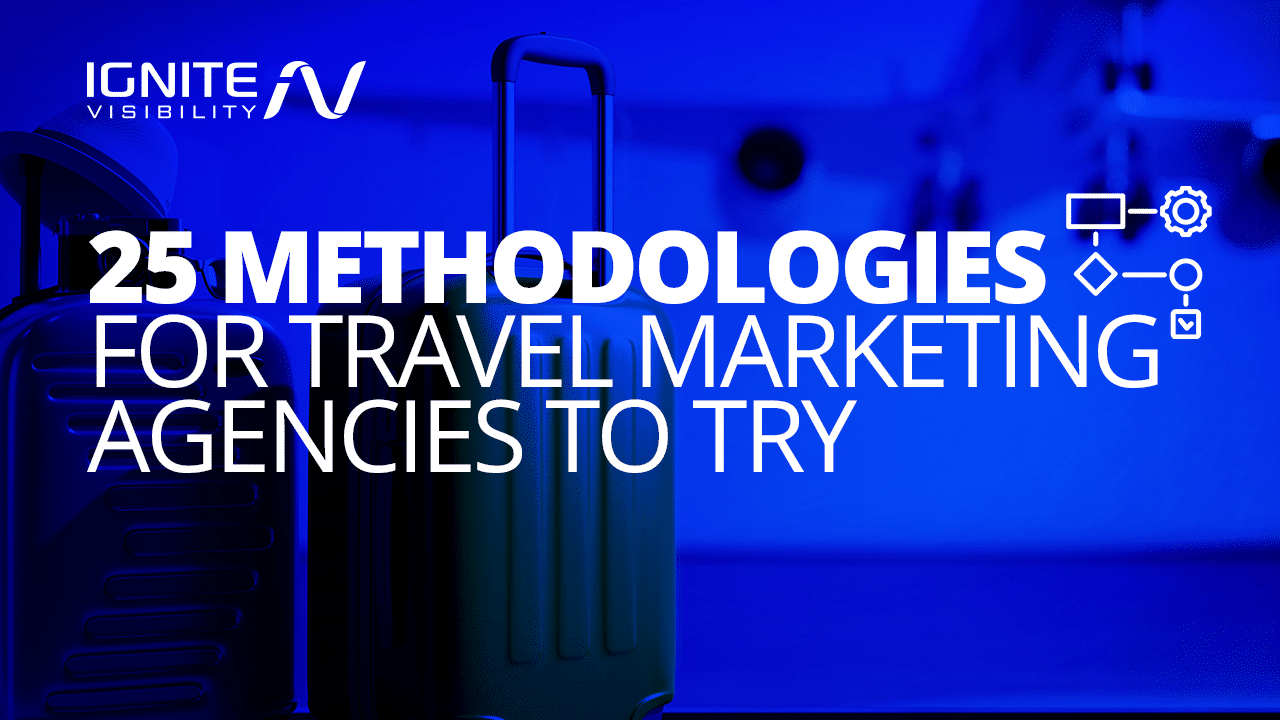
Travel marketing is essential in the tourism industry, offering travel agencies a competitive edge. It involves identifying target audiences, creating impactful marketing materials, and measuring performance across channels.
A travel marketing agency can effectively showcase your services and destinations, enhancing direct connections with audiences. Learn how to leverage travel marketing strategies in this guide to travel marketing agencies.
What You’ll Learn:
- 5 Travel Marketing Trends
Travel Marketing: PPC Strategies
Travel marketing: email strategies, travel marketing: social media strategies to try, travel marketing and seo.
- Travel Marketing: Conversion Rate Optimization
Travel Marketing: Industry Trends
Before jumping into digital marketing for the travel industry , let’s look at some industry trends that might inform that strategy:
- Authentic Experiences: Travelers increasingly seek authentic, local experiences, favoring unique sights over mainstream tourism.
- Remote Work Travel: Post-pandemic, there’s a rise in remote workers traveling for both business and leisure, blending work and travel.
- Solo Travel Among Millennials: A growing trend, especially among Millennials, is the desire for annual solo travel adventures.
- Virtual Vacations: Advances in technology are making virtual travel experiences more accessible, allowing exploration from home.
- Eco-Conscious Travel: Environmental awareness is shaping travel choices, from sustainable transportation to eco-friendly destinations.
PPC (Pay-per-click) advertising is beneficial for all businesses, particularly in travel marketing, where selecting the right keywords is crucial for reaching your target audience.
PPC offers immediate visibility and the potential to generate quick bookings and sales, making it a highly effective channel for promoting limited-time offers and last-minute deals.
Although travel marketing benefits from the inherent appeal of its product, there are strategies to maximize your paid advertising budget’s effectiveness:
1. Create Irresistible Travel Marketing Ads
When crafting PPC ads in travel marketing, it’s crucial to utilize your selling points effectively. Follow these best practices for creating impactful ads:
- Include the target keyword in the headline
- Use call-to-action words like “Book Flights Now”
- Provide social proof, like the number of customers served
- Show starting prices for rooms or flights
- Create urgency by showing deadlines for deals
2. Use Niche-Focused Keywords to Stand Out
What sets your travel-related property apart?
Whether it’s a cosmopolitan hotel near popular bars, exclusive yacht charters, windsurfing classes, or adventurous jungle treks, identifying your unique selling points is crucial.
Travel marketing offers a spectrum from adventure to luxury and relaxation. Success hinges on highlighting what you excel at.
Determine your distinct edge over competitors. This differentiation is the foundation for selecting effective keywords and crafting compelling content. Failing to pinpoint and capitalize on your unique offerings could lead to competitors outranking you and attracting more customers.
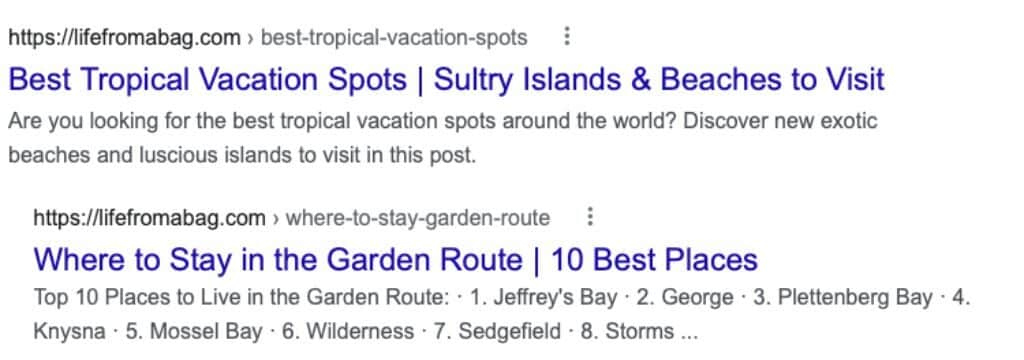
Niche Focused Keywords and Content
3. Change Your Keywords With the Season
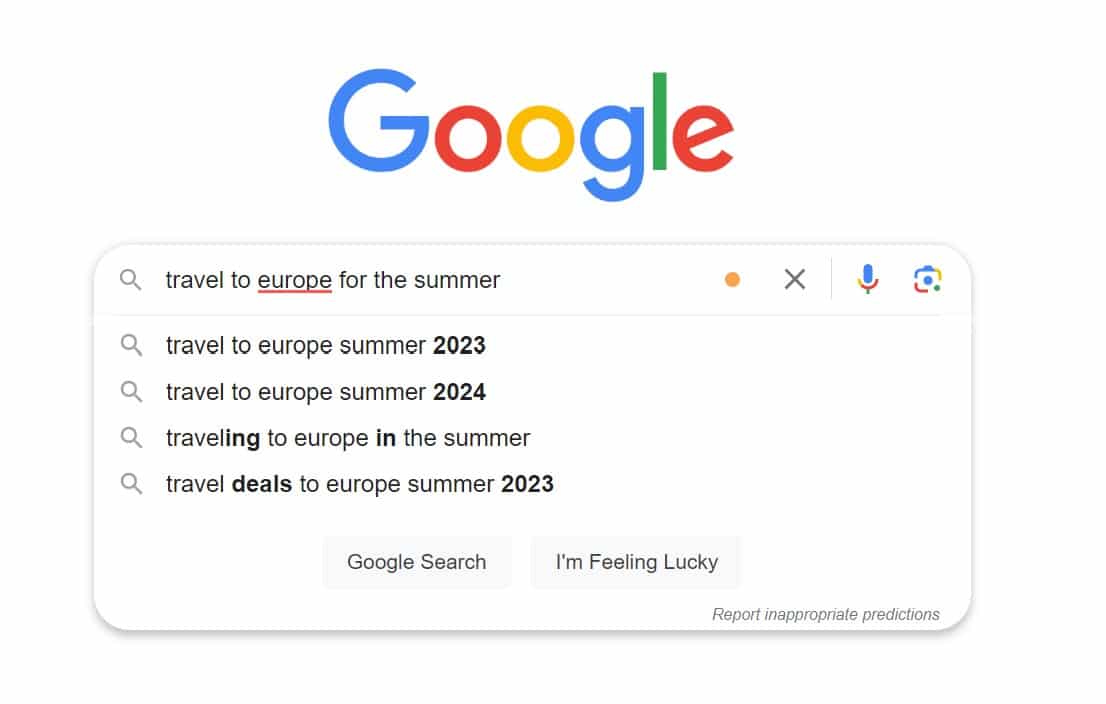
Google search for “travel to europe for the summer”
Travel PPC is all about seasonality and timing.
Before launching time-sensitive deals, identify the peak periods when customers are most active. Then, tailor your keywords to attract travelers looking for a summer getaway or a winter retreat, maximizing your ad budget’s efficiency.
4. Use Negative Keywords
For optimal results in a travel agency’s marketing strategy, incorporating negative keywords in PPC campaigns is essential.
Negative keywords, which are terms you choose not to target, help refine your ad reach, ensuring they are seen by the most relevant audience.
For example, in a luxury travel campaign, using ‘cheap’ or ‘hostel’ as negative keywords ensures your ads won’t appear to users searching for budget options, aligning your ads more closely with your target market.
5. Stick to Long-Tail Keywords in Your Travel Marketing Ads
If you want to stay competitive and reach more specific audiences, include long-tail keywords in your PPC ads.
Long-tail terms consist of three or more words to form a phrase or sentence that people enter into search engines.
For instance, you might use long-tail terms like “best deals on holiday travel packages to Europe” in an ad as opposed to targeting broad terms like “Europe travel.”
You can use various keyword tools to find some low-competition long-tail terms that yield worthwhile search volumes.
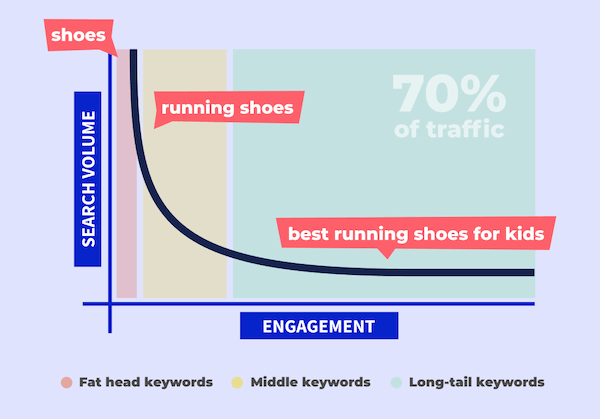
Example of Long Tail Keywords
Email marketing remains a vital and targeted tool in the travel industry, known for its cost-effectiveness in reaching guests and boosting bookings. To keep subscribers engaged and encourage sharing, it’s essential to craft compelling content with attractive offers and deliver them at optimal times.
Key insights from leading travel marketing companies on maximizing email marketing effectiveness include:
1. Grow Your Subscriber List
Capturing the contact information of visitors already on your travel website can be challenging.
To effectively grow your email list, implement these strategies:
- Emphasize the benefits of subscribing, such as exclusive deals or valuable travel tips
- Ensure the opt-in feature is easily accessible and visible
- Employ content upgrades and lead magnets, like downloadable travel guides, to entice sign-ups
- Optimize call-to-action (CTA) buttons for higher engagement
- Utilize exit pop-ups as a last opportunity to encourage subscription
- Incorporate social sharing buttons in emails to expand reach
2. Target Repeat Guests with Behavioral Triggered Emails
Targeting existing customers is easier than trying to generate new leads all the time, and it’s more cost-effective.
Try behavioral-triggered emails! Use personalized email messages sent to users based on their past interactions or behaviors, such as website visits, product views, or abandoned shopping carts.
Think of special packages or time-sensitive reward offers.
These emails are highly effective because they are timely and relevant, addressing the user’s specific interests or actions, which increases engagement, conversion rates, and customer satisfaction.
They automate the process of reaching out to users based on their actions, saving time and resources, and can significantly improve the overall effectiveness of your email marketing campaigns.
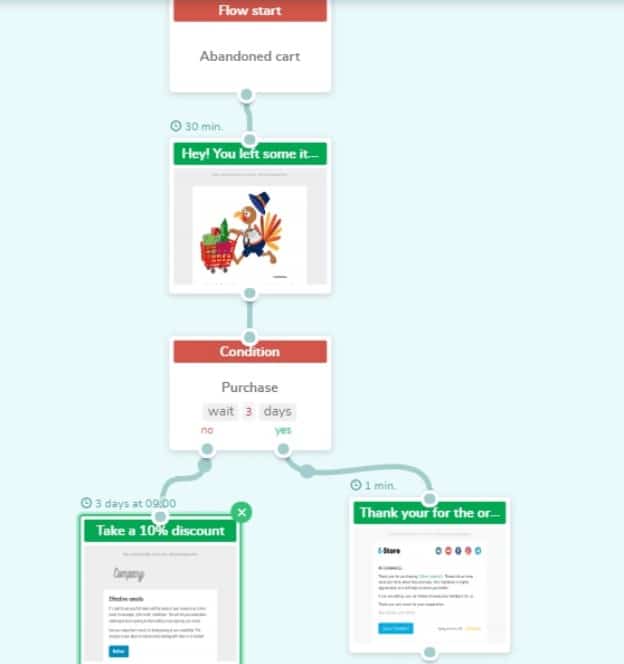
Behaviorally-Targeted Email Sequence
3. Take Advantage of Peak Times
Guests are more likely to look for deals in the lead-up to peak pe riods.
Send them personalized rem inders with holiday-themed emails or last-chance summer vacation deals.
If your audience spans different time zones, sending emails at an appropriate time for each segment ensures that everyone receives the email when it’s most convenient for them.
Consider the timing of your competitors’ emails. Sending your email when there is less inbox competition can improve your chances of standing out.
4. Use Data to Create Hyper-Personalized Offers
Most travel bookings occur online, where customers expect to provide email and personal details.
Leverage this information for post-booking communication, including confirmations, reminders, and time-sensitive offers, facilitating upselling and increased revenue. Additionally, this data enables you to present personalized offers, crucial for customer engagement and loyalty.
Personalization is a key strategy. Reports, like Twilio’s 2023 study, show that 56% of consumers are more likely to become repeat customers through personalized interactions. An American Express study found that 83% of millennials prefer travel companies that offer tailored experiences, even if it involves tracking their patterns.
Further enhance personalization by tailoring email content to individual user preferences, focusing on features of services or locations that align with their interests.
This approach can guide users to specific landing pages with content most likely to engage them, deepening the connection with both potential and existing customers.
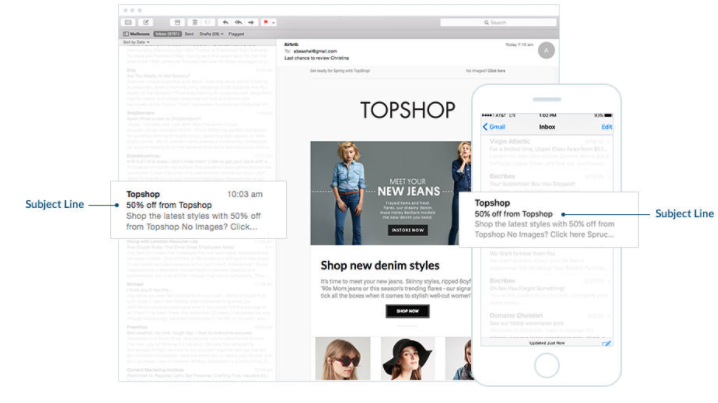
5. Create Unique Subject Lines
Short copy often takes a lot longer to perfect than longer pieces of content. Subject lines should be short, direct, and contain a clear benefit that encourages customers to open.
Once inside, the email must keep readers engaged. So, make sure your emails are friendly and personalized—and contain incentives. A few examples:
- Request feedback in exchange for a discount
- Invite customers to book directly on your website for a discount or a chance to win a prize
- Time-sensitive offers or rewards that encourage guests to book now
Crafting succinct copy, particularly for email subject lines, requires precision. They should be brief, and direct, highlighting a benefit that prompts customers to open the email.
Inside, maintaining engagement is crucial. Ensure your emails are friendly and personalized, and include incentives to spur action. Examples include:
- Offering discounts in exchange for customer feedback
- Inviting direct bookings on your website with discounts or prize opportunities
- Presenting time-sensitive offers or rewards that encourage immediate bookings
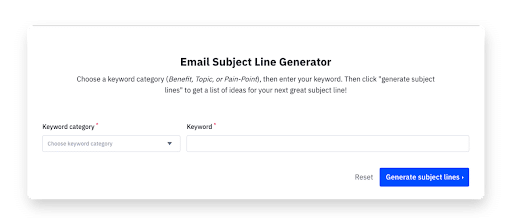
Email Subject Line Generator
Social media can be the key to connecting with your audiences with the help of a travel marketing agency .
Start using your platform to showcase visually appealing destinations and experiences, engaging potential travelers through enticing visuals and storytelling.
Additionally, social media allows for direct interaction with customers, enabling real-time engagement, customer support, and the opportunity to build a loyal community of travelers.
Here are some tips for using social media in digital marketing for the travel industry :
1. Utilize User Generated Content
A good travel marketing company knows that UGC is one of the best ways to create endless content.
To foster UGC, initiate a campaign using a branded hashtag specific to your agency.
Promote this hashtag across platforms, encouraging clients to share their travel experiences and media tied to your services. When customers share captivating photos or videos from their travels, these can be linked to your brand, enriching your travel marketing campaigns.
2. Use Imagery and Video in Your Travel Marketing Social Media Strategy
Vivid travel images and videos on your website and social media play a crucial role in influencing potential customers’ booking decisions.
Enhance your marketing strategy by incorporating videos. While photos capture attention, videos offer a comprehensive view of destinations, rooms, and facilities, providing a more immersive experience.
For instance, Dubai’s Atlantis the Palm effectively utilizes video to showcase its amenities. These videos give potential guests a feel for experiences like swimming with dolphins or exploring the resort, significantly enhancing the appeal of the destination.
3. Influencer Marketing
Collaborating with individuals who have a significant following and influence in the travel niche is a great way to reach new audiences and highlight unique offerings.
Before you select an influencer, be sure they fit your company brand. Choose someone with great engagement that aligns with your company’s message, has similar audience demographics, and produces high-quality content.
It’s a strategic approach to leverage the credibility and reach of influencers to inspire and guide potential travelers in their decision-making process.

Tiers of Influencer Followers from Later
4. Engage and Respond with Your Audience
Engaging with your audience allows travel companies to showcase their brand’s personality and values through content, tone, and interactions.
Liking comments, replying to conversations, and answering DMs can help shape how your audience perceives your business, helping build trust and loyalty.
Use this channel as a direct form of communication with your potential customers. Real-time interactions are unique and allow you to address their questions, comments, and concerns.
5. Host a Contest or Giveaway
Hosting contests and giveaways can create a positive association between your brand and the feelings of excitement and generosity. People are more likely to remember and favor brands that provide enjoyable experiences.
Not only do contests and giveaways foster engagement, but they also help you grow your customer base by collecting valuable data.
When hosting a contest or giveaway be sure to:
- Define clear objectives and rules
- Explicitly state requirements and deadlines
- Create compelling and visually appealing content
Search engine optimization (SEO) is a long-term digital marketing practice that involves keyword research, content creation, link building, and more.
SEO helps travel companies enhance their online visibility and attract targeted traffic, making it a cost-effective way to compete in the travel industry.
Try some of these SEO strategies:
1. Start a Blog
Starting a blog is highly beneficial for travel businesses, providing customers with engaging content beyond just sales.
Travel marketing agencies play a key role in enhancing your blog’s visibility through SEO strategies, including keyword optimization and link building.
High-quality, enjoyable content not only boosts search engine rankings across various topics but also positions your business as a trusted authority in the travel industry.
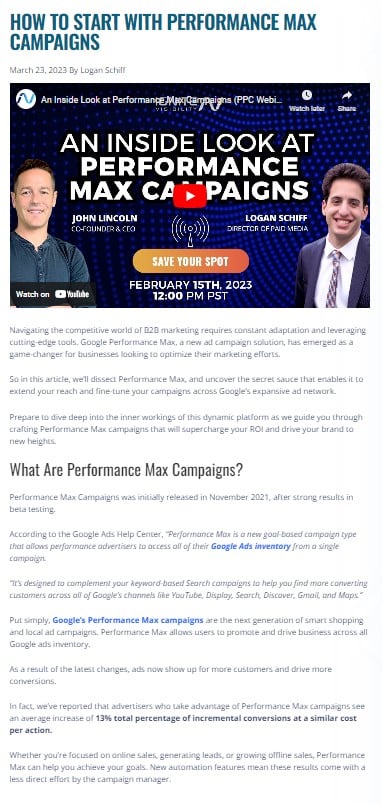
Example of Blog
2. Quality Beats Quantity
In travel marketing, blogging isn’t about producing vast quantities of content; it’s about creating posts that are both informative and inspirational. You’re selling the dream of a fantastic vacation, and your content should reflect this vision.
Exceptional content should either present a new story or tell an existing one in a way that surpasses others. Generic posts about popular destinations like Amsterdam or Disney won’t suffice. Instead, your blog should cater to your specific niche and showcase what makes your offerings unique and appealing.
3. Make It Easy To Get In Touch
Ensuring easy access to contact information is crucial for travel marketing. Follow these steps:
- Place contact details on every page
- Include an enticing CTA button for direct communication
- Offer multiple contact methods: phone, email, chat, and social media
4. Ensure Your GBP (Google Business Profile) is Accurate
Having a Google Business Profile is an essential piece of any SEO strategy for a travel agency. Ensure it includes complete contact details, business information, and physical location directions.
You should also build a Google Business Profile (GBP) to further differentiate your travel agency. This profile includes all contact details and other relevant information about your business, along with directions to your physical locations.
Ultimately, a GBP with accurate contact details can help fully optimize your digital presence for a better travel marketing strategy.
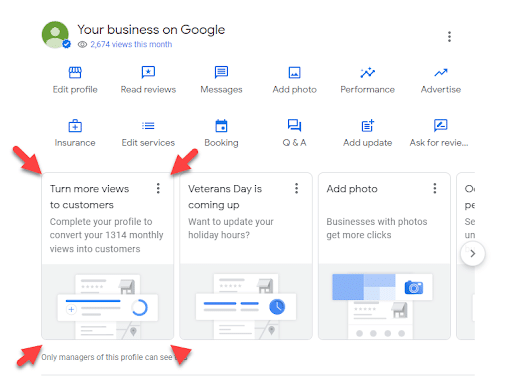
Google Business Profile Manager
5. Use Local SEO Keywords for Travel Marketing
Besides optimizing your website and GBP, you can rely on local SEO to help you compete with other local travel companies and businesses.
Stand out in local searches by creating content around “near me” search terms as well as location-based keywords, branded keywords, localized variations of keywords, and more.
While it’s not SEO, exploring geo-targeted ads will help you reach customers who are in your vicinity, taking advantage of location-specific campaigns.
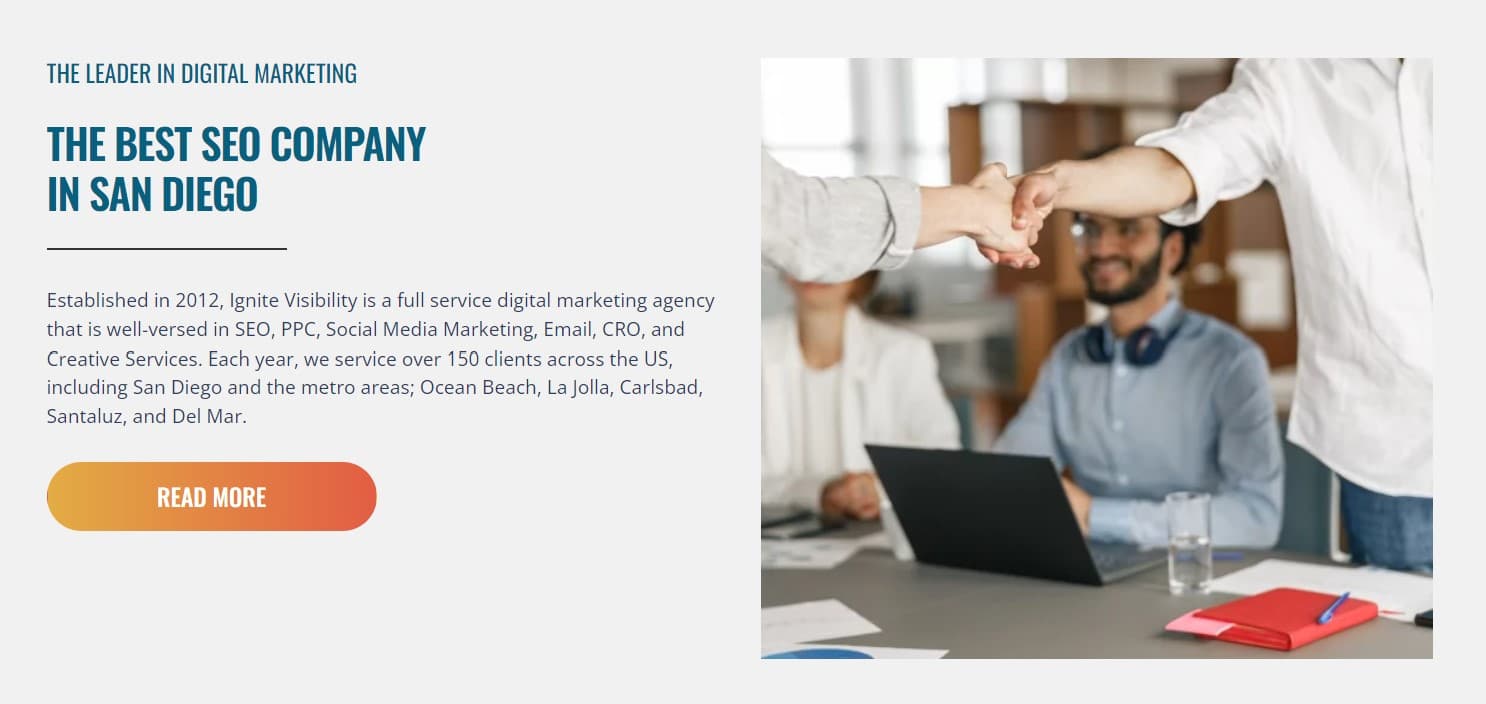
Example of Using Landmarks for “Near Me” SEO Searches
Travel Marketing with Conversion Rate Optimization
Conversion Rate Optimization (CRO) is crucial in travel marketing as it directly impacts the ability to convert website visitors into paying customers, maximizing the return on marketing investments.
By optimizing the user experience and streamlining the booking process, CRO ensures a more effective and satisfying customer journey. This leads to increased bookings and revenue, making CRO an indispensable part of successful travel marketing strategies.
Start implementing these strategies to improve your travel marketing CRO:
1. Develop a Killer Mobile Experience
Mobile optimization is essential in travel marketing. Booking.com reports that 59% of travel bookings are made on mobile devices, with research often conducted via smartphones and tablets.
For a seamless mobile experience, ensure your website adheres to these principles:
- Web copy should be readable with appropriate spacing, fonts, and colors
- Enable click-to-call functionality for easy contact
- Integrate Google Maps for location guidance
- Avoid using Adobe Flash
- Minimize pop-up use to enhance user experience
- Ensure the logo links back to the homepage
- Make calendar and search functions easily accessible
- Use auto-fill on forms for returning customers
2. Keep UX at the Forefront of Your Website
Ensure a streamlined User Experience (UX) that is simple, clear, and concise. Your website should be easy to navigate, enhancing the customer journey.
Be sure to:
- Design a mobile-friendly interface for various devices
- Maintain a loading speed of two seconds or less
- Developing a multilingual site for global visitors
- Creating an intuitive web design for a seamless user journey
3. Make Booking Seamless
Additionally, implement a smart booking engine that syncs room and pricing information across all platforms.
This ensures consistency, whether bookings are made online or via mobile, providing a clear and updated overview for every visitor.
Minimize the number of steps to book, offering clear calls-to-action, easy navigation, and providing various secure payment options.
4. Rely on A/B Testing to Show You What Works (And What Doesn’t)
Regularly conducting A/B testing on key travel website elements like landing pages, headlines, and calls-to-action will help you determine what works best in engaging and converting visitors.
Coupled with in-depth analytics, this strategy helps in understanding user behavior and preferences, allowing for continuous improvement of the user experience and conversion rate.
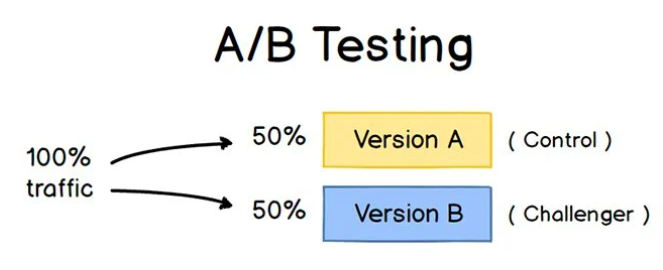
What is A/B testing?
5. Incorporate Social Proof with Customer Reviews
Encouraging guests to leave online reviews is vital in travel marketing. Avoid offering incentives as this may appear as buying positive reviews.
Instead, simplify the review process. Use tools like TripAdvisor’s widget for easy onsite feedback, and Yelp’s Review Badges to display positive reviews as a visual prompt, along with a call-to-action (CTA) linking to your Yelp page.
Addressing negative reviews is also crucial. Ignoring them can create a negative impression, as seen on Expedia’s Trust Pilot page. Responding to complaints shows customers they are valued and can transform negative experiences into positive ones.

Poor Negative Reviews
Partner with Ignite Visibility for Travel Marketing
As you can see, successful travel marketing depends on implementing a wide range of strategies from PPC to video, to making sure your site is optimized for mobile bookings.
Employ these tips listed above, and you’ll have a top travel marketing company in no time.
Want to get the best results with your travel marketing approach? Turn to a reliable digital marketing agency for travel businesses and get the help you need.
At Ignite Visibility, we can help you with everything from search engine optimization and PPC to email marketing to build a complete travel marketing campaign based on your unique requirements.
In doing so, we’ll help:
- Locate and reach your target market
- Develop fully optimized campaigns that get results
- Continually monitor and measure performance
- Perfect your efforts to get increasingly great results
If that sounds like a plan, reach out to the experts at Ignite Visibility for help today!

About John Lincoln
John Lincoln is CEO of Ignite Visibility, a top digital marketing agency and a six-time Inc. 5000 company. Lincoln is a frequent speaker, author of Digital Influencer, The Forecaster Method, Advolution, and creator of SEO: The Movie and Social Media Marketing: The Movie. He is consistently named one of the top digital marketers in the industry and has received the Search Engine Land "Search Marketer of the Year" award. Lincoln has taught digital marketing and web analytics at the University of California, San Diego since 2010 and has been named as one of San Diego's most admired CEOs and a top business leader under forty.

Travel Marketing: Strategies That Work
In the travel industry, the success of one’s business is greatly influenced by the effectiveness and creativity of their marketing strategies. At its core, travel marketing is the linchpin, connecting destinations with dreams, services with experiences, and accommodations with adventures.
It’s the art and science of inspiring potential travelers, guiding them from initial curiosity to the final act of booking. The importance of travel marketing cannot be overstated; it is the driving force that propels travel companies, agencies, and destinations into the spotlight of their target audience.
As we delve deeper, emerging technologies like virtual reality, mobile apps, and augmented reality continually reshape the tourism industry’s landscape, making marketing efforts more interactive and immersive.
These tools and traditional digital marketing , such as email marketing, social media, and SEO, form the backbone of an effective marketing strategy. They allow travel brands to weave compelling narratives around travel destinations, showcasing unique selling points through engaging content, virtual tours, and real-world settings.
Effective marketing strategies—crafting engaging social media posts, leveraging user-generated content, or executing targeted email campaigns—cannot be underestimated in driving the success of travel companies and destinations. These strategies ensure that every marketing effort is a step towards enhancing the customer experience, engaging potential travelers, and building a loyal customer base.

Online travel agencies and tour operators vie for attention on various platforms, the need for standout travel marketing tips and strategies has never been more critical. The best travel marketing tips hinge on understanding the specific demographic of your target market, engaging with them through high-quality content on platforms they frequent, and utilizing data analytics tools like Google Analytics to refine your approach.
For travel agencies, travel agents, and all stakeholders within the travel business, embarking on refining or reinventing your travel marketing strategy means embracing many digital tools—from SEO to influencer marketing and virtual reality tours to social media marketing campaigns. These tools aim to attract visitors to a particular destination and enhance the overall marketing campaign cost-effectively and efficiently, ensuring that marketing content resonates well with prospective customers.
Table of Contents
The Essence of Travel Marketing: Creating Dreams into Destinations

Travel marketing stands at the intersection of aspiration and action. It embodies the essence of inviting potential travelers to leave their comfort zones and explore the vast, vibrant world beyond. It is an intricate blend, where strategy and creativity converge to capture the imagination of prospective customers and inspire them to embark on journeys anew.
At its heart, travel marketing seeks to communicate the unparalleled joy and enrichment that comes from discovering new travel destinations, experiencing diverse cultures, and making memories that last a lifetime.
The core objectives of travel marketing are to raise awareness, spark interest, and ultimately drive bookings for travel services offered by travel agencies, online travel agencies, tour operators, and travel companies.
Through a meticulously crafted mix of digital marketing tactics—including social media marketing, email marketing, content marketing, and search engine optimization—travel marketers strive to reach their audience online, from social media platforms to review platforms and beyond.
But travel marketing goes beyond mere promotion; it is about weaving stories that resonate, leveraging user-generated content and virtual tours to bring real-world settings to vivid life. With VR and AR, potential travelers can get tantalizing previews of what awaits them, leaping from dreaming to booking faster than ever.

This technological evolution, coupled with traditional yet powerful techniques like engaging email campaigns and informative blog posts, creates a multifaceted approach capable of reaching customers on mobile devices and desktops alike.
The primary purpose of tourism marketing is to inspire, persuade, and invite travelers to explore specific destinations, experiences, or services. It’s about highlighting a destination’s unique selling points and showcasing the beauty and thrill of travel destinations through engaging content and spectacular imagery. Travel marketing strategies aim to make the idea of travel irresistible, turning potential travelers’ wanderlust into concrete travel plans.
Practical travel marketing efforts rely heavily on understanding the specific demographic of the target market. It involves comprehensive market research to tailor marketing strategies that resonate with the target audiences’ interests, preferences, and behaviors.
The best travel marketing tips always emphasize the importance of aligning marketing content with the values and desires of prospective customers, ensuring that every social media post, marketing campaign, and piece of marketing content is designed to attract visitors and convert interest into action.
In a highly competitive tourism industry, standing out requires following the latest travel marketing strategies and setting the trends. From leveraging the power of influencer marketing to enhance customer engagement and crafting memorable marketing campaigns that utilize the cost-effectiveness of digital marketing to providing valuable information through high-quality content and answering queries with precision—every aspect of travel marketing is about enhancing the customer experience and building a robust customer base.
Travel agencies and travel businesses are thus challenged to adopt a marketing strategy that captures the essence of their brand and the destinations they promote and speaks directly to the hearts and minds of potential travelers. This involves utilizing traditional and innovative marketing channels, from social media to virtual reality, to create immersive experiences that make travelers feel as though they’ve already begun their journey, even before booking their trip.
As we navigate the travel industry, the role of travel marketing becomes increasingly significant. It’s about offering discounts that matter, using mobile apps to ease the journey, deploying ad campaigns that capture attention, and ultimately, ensuring that your travel brand becomes synonymous with adventure, relaxation, and everything in between.
For travel marketers, embracing the latest travel marketing strategies and tips means continuously experimenting, adapting, and exceeding the expectations of today’s discerning traveler.
In the quest to attract visitors and convert them into loyal patrons, travel marketing is a journey that requires passion, innovation, and a deep understanding of the tourism industry’s dynamics. It is a journey of connecting with potential travelers personally, making every marketing effort count in the quest to turn travel dreams into tangible realities.
Key Strategies for Effective Travel Marketing

In the travel industry, distinguishing your travel brand requires not just a presence but a profoundly impactful one. Here, we delve into the crux of strategies that empower travel companies to navigate and lead in the competitive arena of tourism marketing.

Understanding Your Audience
Understanding your customers is essential for a successful travel marketing strategy. This entails conducting market research to grasp prospective customers’ preferences, behaviors, and motivations. Travel agencies and marketers must tailor their marketing messages to meet their target market’s needs and desires, whether catering to luxury travelers, adventure seekers, or business trip clients.
Identifying and segmenting your target audience ensures that your marketing efforts resonate on a personal level, significantly increasing the likelihood of converting interest into bookings.
Leveraging Digital Platforms
Effectively utilizing digital platforms is indispensable for travel marketers. Social media, content, and email marketing are key channels for reaching potential travelers, offering a direct line to your audience where they spend considerable time: on their mobile devices.
The role of SEO and search engine marketing (SEM) extends beyond mere visibility; it’s about ensuring that when prospective customers search for travel destinations or services, your brand appears front and center on search engines. This digital approach broadens your reach, enhances customer engagement, and drives more traffic to you online.
The Power of Storytelling
Storytelling transcends traditional marketing by creating an emotional and personal connection. For travel businesses, leveraging real stories and experiences can significantly enhance their brand’s appeal. Through engaging content, virtual tours, and immersive real-world settings, storytelling can transport potential travelers into the narrative, making the brand’s experience irresistible.
This approach builds a deeper connection with your audience, turning abstract services into tangible desires.
Influencer and Affiliate Marketing
Where social proof reigns supreme, collaborating with influencers and engaging in affiliate marketing present unparalleled opportunities for travel brands to expand their reach. Influencers can tap into new audiences, lending their credibility and audience to your brand. Affiliate marketing, on the other hand, leverages partnerships to promote travel services, offering a performance-based approach that can significantly increase bookings.
Both strategies are vital in a comprehensive travel marketing plan, offering cost-effective ways to attract visitors and enhance the travel customer experience.
Data-Driven Marketing
The pivot towards data-driven marketing strategies marks a turning point in how travel agencies and companies approach their marketing efforts. Data analytics allows marketers to understand customer behavior, refine marketing strategies, and precisely measure the return on investment (ROI).
This analytical approach enables travel businesses to adjust their strategy based on performance data, ensuring that every marketing campaign is optimized for maximum impact and cost-effectiveness.
Implementing these key strategies in your travel marketing efforts can dramatically transform how your travel agency or company connects with potential travelers. From the strategic utilization of digital platforms and SEO to the compelling power of storytelling and the targeted approach of influencer marketing, each element plays an important role in attracting your audience.
Moreover, grounding your marketing strategies in data ensures that your efforts are creative but also smart, adaptable, and results-driven. In the competitive landscape of the tourism industry, where every travel brand vies for attention, these strategies are not just recommendations—they are the cornerstones of success in travel marketing.
Navigating the Trends in the Travel Industry

In the travel industry, staying abreast of current trends is not just beneficial—it’s imperative for survival and growth. Travel marketing is changing, shaped by technological advancements, changing consumer preferences, and the global economic climate.
Travel agencies, tour operators, and travel companies must adapt and innovate, ensuring their marketing strategies are as fluid and flexible as the trends they follow.
Embracing Digital Transformation
The digital transformation within the tourism industry has accelerated, with virtual reality (VR) tours, augmented reality (AR) experiences, and mobile apps becoming increasingly integral to travel marketing strategies. These technologies offer potential travelers immersive previews of destinations, enhancing the customer experience before their journey begins.
Travel brands leveraging these tools in their marketing campaigns find themselves at the forefront, captivating their target audience’s imagination and converting interest into bookings more effectively.
UGC and Influencer Marketing
User-generated content (UGC) and influencer marketing have emerged as powerful tools in the travel marketer’s arsenal. Encouraging customers to share their real-world experiences on social media and review platforms provides valuable information to prospective customers and builds trust and credibility for your brand.
Collaborating with influencers, on the other hand, can amplify your reach and attract visitors from new demographics and markets.
These strategies, rooted in authenticity, can significantly enhance engagement and foster a sense of community around your travel brand.
Personalization and Customer Engagement
Personalization is key to capturing the attention of potential travelers. Customized email marketing campaigns , push notifications, and landing pages that cater to your target market’s specific interests and preferences can dramatically improve customer engagement.
Travel businesses can boost marketing effectiveness by crafting personalized messages with data analytics and market research to understand their customer base.
Sustainable and Responsible Travel
As environmental concerns take center stage globally, sustainable and responsible travel has become a compelling, unique selling point for many travel destinations and services.
Travel companies that highlight their commitment to sustainability in their marketing content align with the values of a significant segment of their target audience and contribute to a larger movement towards eco-friendly travel.
This approach enriches the customer experience and positions your brand as a responsible leader in the tourism industry.
Leveraging SEO and Other Search Engines
With most customers beginning their travel planning journey online, the importance of SEO and visibility on other search engines cannot be overstated. A well-thought-out SEO strategy ensures that your travel services appear prominently when potential travelers search for related keywords.
This, combined with engaging content and high-quality visuals online, can significantly increase traffic and conversion rates.
Adaptation and Innovation
To stay ahead in the travel industry, businesses must constantly adapt their marketing strategies . This means keeping an eye on the latest travel marketing strategies, understanding the evolving preferences of your target audience, and being ready to pivot your approach based on performance data and industry trends. Whether exploring new digital marketing avenues, adopting the latest VR technology, or refining your social media strategy, the willingness to innovate can set your travel brand apart.
Navigating the trends in the travel industry requires a proactive and dynamic approach to travel marketing. Travel marketers can ensure their brand survives and thrives by embracing digital transformation, leveraging user-generated content, personalizing customer engagement, promoting sustainable travel, and optimizing search engines.
Conclusion: Charting the Course for Success in Travel Marketing

As we draw the curtain on this exploration of effective travel marketing strategies, it’s clear that the path to success in the travel industry is dynamic and multifaceted. The landscape of travel marketing is constantly evolving, shaped by new technologies, changing consumer behaviors, and the global push towards more sustainable practices.
For travel agencies and travel companies, staying ahead means embracing innovation, understanding the needs and desires of your audience, and continuously refining your strategies to align with the latest trends.
The key takeaways from our journey through the essentials of travel marketing underscore the importance of leveraging digital platforms, engaging in storytelling, utilizing influencer and affiliate marketing, and adopting a data-driven approach to understand and connect with potential travelers. By implementing these strategies, travel marketers can enhance the customer experience, attract visitors to various travel destinations, and drive bookings and growth for their businesses.
Virtual reality, augmented reality, and mobile apps offer an unparalleled opportunity to bring destinations to life, offering virtual tours and engaging content that captivates prospective customers’ imaginations. Moreover, the power of user-generated content and influencer marketing in building trust and credibility cannot be overstated. These elements, combined with targeted email marketing campaigns and a robust social media strategy , are vital in creating a compelling digital presence that speaks directly to the heart of your target.
Yet, the foundation of all these efforts lies in understanding your audience. Market research, search engine optimization, and leveraging data analytics provide invaluable insights into the preferences and behaviors of potential travelers, allowing for the creation of personalized and effective marketing campaigns.
Adopting the latest travel marketing strategies and tips in an industry as competitive as tourism is not just a recommendation—it’s a necessity. From enhancing your social media posts to optimizing your website for mobile devices and other search engines, every aspect of your marketing plan should aim to provide valuable information, answer queries, and offer discounts that resonate with your specific demographic.
Let this exploration of travel marketing strategies serve as a beacon, guiding your marketing efforts toward innovation and success. The potential for growth and achievement in travel marketing is boundless for those willing to change, try new ideas, and adapt to the travel industry. Remember, the essence of travel marketing is not just to sell a service but to inspire dreams, cultivate experiences, and enrich lives.
FAQ: Navigating the World of Travel Marketing
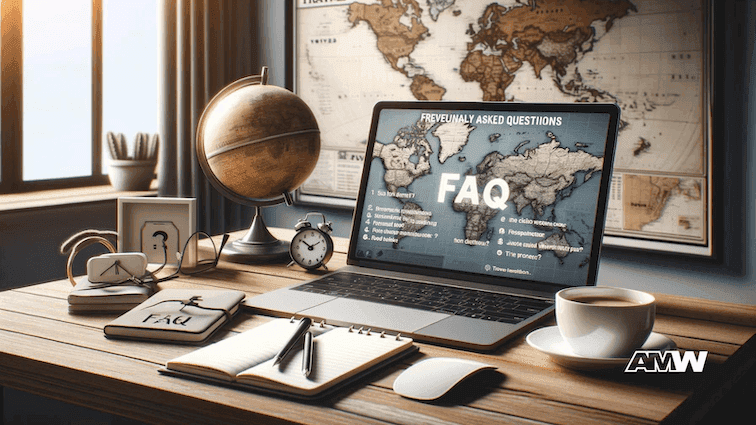
In the travel industry, questions abound regarding how to effectively market travel services and destinations. Here, we delve into some of the most pressing queries, offering insights and strategies to help travel agencies, tour operators, and companies navigate the complex world of travel marketing.
What is the best marketing strategy for a travel agency?
Understanding your audience is the cornerstone of any successful travel marketing strategy. The best strategy involves tailoring your approach to meet your audience’s interests, needs, and desires and effectively leveraging digital platforms. Incorporating a mix of social media marketing, SEO, content marketing, and email campaigns will ensure that your travel agency reaches a wider audience and engages potential travelers in meaningful ways.
How do I advertise my travel agency online?
Using digital marketing tools and platforms to advertise your travel agency online effectively. Use social media to create engaging posts and share high-quality content showcasing your unique selling points and travel destinations. Use SEO strategies to improve your visibility, making it easier for customers to find you. Content marketing can provide potential travelers with valuable information and immersive experiences through blogs and virtual tours. Additionally, email marketing campaigns allow for personalized communication, offering discounts and updates directly to your target market.
What is an excellent online marketing strategy?
A good online marketing strategy is comprehensive and multifaceted, incorporating SEO, content marketing, social media engagement, and data analytics to drive decisions. It focuses on creating high-quality content that resonates with your audience, using social media to foster customer engagement, and analyzing data to refine and optimize marketing efforts. A successful strategy also adapts to the latest travel marketing strategies and technologies, such as virtual reality and mobile apps, to enhance the customer experience and ensure your marketing content stands out in a competitive landscape.
What is the meaning of travel marketing?
Travel marketing is the dynamic process of promoting destinations , services, or experiences to potential travelers. Its primary aim is to inspire and persuade individuals to embark on journeys for leisure, business trips, or cultural exploration. Through various marketing channels and strategies, travel marketing seeks to connect with prospective customers, highlight the unique attractions of travel destinations, and, ultimately, drive bookings and travel activity.
What is the primary purpose of tourism marketing?
Tourism marketing aims to attract visitors to a destination by highlighting its unique attractions, culture, and experiences. It involves crafting compelling reasons for travelers to choose a particular destination over others through engaging content, captivating visuals, and targeted marketing campaigns. Tourism marketing aims to enhance the visibility of travel destinations , improve customer engagement, and contribute to the overall growth of the tourism industry.
How do you market a destination?
Marketing a destination requires a strategic approach that showcases its unique attractions, culture, and experiences. This involves researching your audience’s preferences and using marketing channels to tailor your messaging. Engaging content, including virtual tours, high-quality images, and user-generated content, can bring the destination to life for potential travelers. Influencer marketing can also be crucial in attracting new audiences by leveraging the reach of influencers who align with your brand’s values and demographic.
Adopting these strategies and tips can help travel agencies and companies navigate the complexities of travel marketing and achieve their marketing goals. By focusing on understanding your target audience, leveraging the latest digital marketing techniques, and continuously innovating your approach, the potential for success and growth in the travel industry is boundless.

- Skip to primary navigation
- Skip to main content
Postalytics
Direct Mail Automation
November 23, 2023 by MADX
7 Travel Marketing Strategies to Win Travelers
Revenue for the travel and tourism market is expected to grow at an annual rate of 4.42%. By 2027, the projected market volume is over one trillion dollars.
As travelers return to their normal traveling frequency, competition is soaring again. Travel companies must develop new and innovative ways of getting their services in front of potential customers.
Travel marketing has become increasingly important. Many competitors are finding success in a cluttered industry thanks to innovative marketing. As a direct mail automation platform, we have observed what makes travel marketing unique and how you can create strategies to attract travelers to your business.
Let’s strap in and begin our journey.
What We’ll Cover:
- What is Travel Marketing?
- #1 Direct Mail Marketing
- #2 Content Marketing
- #3 Video Marketing
- #4 Influencer Marketing
- #5 Email Marketing
- #6 User-Generated Content
- #7 Virtual Reality Marketing
- #1 Define Your Target Audience
- #2 Target Travel-Related Keywords
- #3 Don’t Oversell
- #4 Retarget Audience Interest
- #5 Focus on Visuals
- #6 Reach Out to Micro-Influencers
- How Can Direct Mail Help Travel Marketing Campaigns?
- Elevate Your Travel Marketing Campaigns
What is Travel Marketing?
Traveling marketing involves all the marketing strategies you use to;
- Generate leads
- Attract more website visitors
- Drive social media visibility
- Strengthen your brand
- Convert customers
- Increase sales
- Improve customer retention
It encompasses all the marketing campaigns you run on different platforms, like content marketing, advertising and social media marketing, to capture the attention of all types of travelers, like adventure seekers, business travelers, or vacation planners.
It’s important to note that travel marketing includes all businesses in the industry, like hotels, resorts, travel agents, transportation companies, airline companies, lodging businesses, tour operators and tourist destinations.
7 Effective Travel Marketing Strategies
Travel marketing allows brands to create stories and draw more eyes to their business. A proper investment in travel marketing strategies allows marketers to generate enthusiasm, entice tourists, and drive economic growth.
Here are seven such strategies you can adopt.
#1 Direct Mail Marketing
Did you know that the travel and hospitality industry ranks second in the usage of direct mail ? This is because direct marketing is a great way to reach travel customers. Personalized direct mail can surprise and delight travelers.
There are a lot of creative ways you can print your direct mail postcards and brochures to create an engaging experience for your audience. For example, you can use pop-ups, window printing, specialty inks, embossing, and debossing to create attractive mail.
Many travel marketers also use destination pictures to create a visual impact and evoke certain emotions.
If you think direct marketing is complicated and requires a lot of time, think again. With the advent of direct mail tools like Postalytics, you can access;
- Readymade templates
- Personalize campaigns at scale
- Get address verification functionality
- Dashboards to track the success of your campaign
- pURLs & QR codes for easy online tracking
It means you can create, send, and track campaigns with ease.
#2 Content Marketing
Investing in content marketing can pay off well in the long run. With so many different content formats like blogs, videos, podcasts, ebooks, etc., you can be as creative as you want.
One format that you should capitalize on before moving to others is blog content. An engaging blog can target your audience’s questions, offer tips and suggestions that the audience finds valuable, and persuade those who wish to travel.
Booking.com ’s blog is the perfect inspiration for you.
Here are some best practices you can adopt to get the most out of this travel marketing strategy:
- Perform keyword research to find the keywords and phrases your target audience is searching for.
- Understand your audience and create relevant content.
- Master the usage of powerful and persuasive copy and CTAs.
- Perform competitor research to find the content types getting the most engagement.
- Experiment with recent trendy content formats like Instagram reels and YouTube shorts.
- Create a newsletter with your top-performing content to get even more benefits out of your popular content.
#3 Video Marketing
According to Oberlo’s video marketing survey, the demand for video content is increasing, with 91% of consumers wanting to see more video content from brands.
This holds even more true for the travel and tourism industry. For example, take these two options:
Option A: A detailed landing page talking about how to set up an itinerary for Italy
Option B: A YouTube video that shows the different things you can cover in Italy for your itinerary
Which one would you prefer first? The last option, right? That’s because this industry is heavily dependent on visuals. Visuals help you show off destinations and your hospitality business in full glory.
Here’s how G Adventures creates powerful travel videos on YouTube.
You can also tell compelling stories with videos. And the best part? You don’t need an extensive budget for this travel marketing strategy. You only need some basic tools like Vimeo and Adobe to get started.
#4 Influencer Marketing
Partnering with relevant influencers in your niche can help you reach a wider audience and get more visitors to your social profiles or website.
When you work with great names in the industry, it also does a lot to improve the trust and credibility people have in your brand.
One question marketers often have with influencer marketing is, “Wouldn’t this strategy be very costly?”
No! With the advent of micro and nano-influencers, even small businesses and travel agencies can adopt influencer marketing. Here are some questions to ask before choosing influencers for your campaigns.
Before moving ahead with this strategy, ensure you have a plan drawn out which answers questions like:
- What will be the budget spend?
- How many posts/videos/articles are we looking to collaborate on?
- Will we let the influencer create content independently, or will we have a set of guidelines?
- How will we compensate the influencers?
#5 Email Marketing
Email marketing can be a great way for travel marketers to nurture travel leads and build relationships. But it’s not as easy as writing a generic email and sending it to 200 subscribers on your list.
Instead, here are some tips to help you create effective travel email campaigns:
- Embed beautiful visuals and videos : Instead of sending the same mundane emails, by adding a short video to your email, you can engage your audience and improve response rates.
- Use email automation: Create triggered email workflows to send the right message to the right person at the right time. Here’s a workflow example.
- Personalize your campaigns: Email personalization can improve your open rates by 82% . So, get customer preferences and use them in campaigns.
- Get creative with subject lines: As travel marketers, your subject lines should be such that they draw the recipients in and push them to open the email. You can even use A/B testing to find the right subject lines.
Here’s an email campaign by a travel business, Carnival Cruise Line, to inspire you.
Image source
#6 User-Generated Content
User-generated content (UGC) is any content created by the users of your company that reflects their experiences with your services or brand.
Utilizing this in your campaigns, websites, or blogs can help build trust and social proof. After all, people trust other travelers more than they trust branded content.
Here’s how you can use UGC:
- Embed reviews on your homepage or targeted landing pages.
- Create a separate page on your website to display your customer’s pictures, such as their stay in your hotel.
- Use these visuals in your email campaigns. For example, if you’re sending details about an upcoming trip to Indonesia, embed pictures of your customers having fun on the pristine beaches of Bali.
- Design an attractive brochure with UGC and send it via direct mail platforms.
To source these visuals, you can ask your customers via email, or you can create branded hashtags on social media and encourage customers to use those while uploading their pictures.
#7 Virtual Reality Marketing
We have seen virtual reality applications in many areas of our lives, whether gaming or the beauty industry. With VR offering a realistic experience, travel marketers can use it to create memorable and immersive experiences.
For example, you’ll see many hotels and resorts offering a virtual tour of their resort. The 360-degree videos make you feel as if you are right in the hotel. This makes visitors feel like the main character in your story and helps build strong relationships.
Here’s a YouTube video that shows what this experience feels like.
You could create virtual guided city tours, wine-tasting tours, or virtual visits to museums and galleries. To find how effective this is, many travel companies ask recipients to scan QR codes to access these tours and then track their activity.
6 Best Tips for Travel Marketing Campaign
We’ve covered the different marketing strategies you can implement. Now, it’s time to find out how you can create effective campaigns with these strategies. Here are six travel marketing tips you should follow.
#1 Define Your Target Audience
Not all travelers are the same. While you might have something for each traveler, you want to create separate buyer personas to target different audiences with different campaigns. This can help create more effective marketing campaigns.
For example, while adventure seekers may want to spend extra bucks on adventure activities, luxury travelers may not mind spending lots on expensive hotels and resorts.
To create detailed buyer personas, consider demographics, interests, pain points, and travel preferences. You can conduct surveys or pay close attention to visitors’ activity on your website to find this information.
#2 Target Travel-Related Keywords
You might want to create an article on “How to select the right travel agency?” But are people searching for this keyword? If not, you’re wasting your resources.
To find this out, you can use keyword research tools like Ahrefs , Google Keyword Planner , or Semrush .
Not only can you use these keywords for your articles or YouTube videos, but you can use them for search ads as well.
If you’re just starting, ensure you don’t go after high-search volume keywords, which are generally very competitive. Start with long-tail keywords or keywords that have a moderate difficulty level.
#3 Don’t Oversell
Have you ever unsubscribed to a brand because they were very pushy? That’s one thing travel marketers should avoid at all costs.
You need to strike a balance between promoting travel services and providing valuable information.
For example, if someone booked a trip to Thailand, you can send them valuable content about attractions to visit in Thailand, how to book island tours or the food they should not miss out on. You can then insert links in these articles where customers can pre-book tours or other activities.
This way, you’re not aggressively marketing your add-ons. At the same time, you’re providing your customers with valuable information.
#4 Retarget Audience Interest
Retargeting in the travel industry focuses on reconnecting with those leads or customers who have shown interest in your product/service once. This helps convert those who just need that extra nudge to rent a room in your hotel or book a tour from your agency.
You can use website tracking pixels and data analysis to identify valuable retargeting opportunities. One major way travel marketers retarget audience interest is by using search ads or showcasing ads on social media platforms.
To get the most out of this strategy, ensure your ads are compelling enough to remind travelers of their interest in your services.
Here’s how SkyLux Travel uses retargeting ads with irresistible discounts.
#5 Focus on Visuals
Visual content is the go-to content for travel and tourism marketing. After all, you can write a hundred flamboyant words on how beautiful Spain is. Still, it’ll only make a lasting impact if you support those words with high-quality images and videos of Madrid, Seville, or Ibiza.
Ensure you optimize visuals for mobile devices and social media platforms and maintain consistency in branding through visual elements.
If you’re using direct and email marketing, add visuals to get better open rates and conversions. You can even A/B test these campaigns to understand the impact visuals have on your KPIs.
#6 Reach Out to Micro-Influencers
A micro-influencer is an influencer with a follower count of 10,000-100,000 followers. These influencers are the best option for brands looking to get a broader appeal with their campaigns on a budget.
These micro-influencers charge less, have a more engaged following, and have a more targeted or niche audience, all of which benefit travel marketers.
You can do a manual search on social platforms or work with influencer marketing agencies to get a list of micro-influencers you can work with.
How Can Direct Mail Help Travel Marketing Campaigns?
Many travel agencies and related businesses use direct mail to create a tangible and memorable experience for their clients.
With different direct mail formats and printing methods, you can create beautiful direct mail pieces that capture attention and improve your brand’s visibility.
Direct mail automation tools like Postalytics streamline the creation and delivery of direct mail. With access to readymade templates, functionality to add pURLs & QR codes, and the ability to personalize each direct mail piece at scale, you’re all set to carry out your direct marketing efforts seamlessly .
Vacation Reputation, a leading-edge solution tailored for vacation rental management companies, used Postalytics to market their services. They loved that there were no minimum order sizes, and they could personalize and automate direct mail.
After adding Postalytics to their list of services, one of their clients signed six new properties after sending only 2100 postcards. That’s an incredible conversion rate to cold outreach in this industry.
Elevate Your Travel Marketing Campaigns
With these travel marketing strategies, you’re ready to create campaigns that convert. Before you start, ensure you have done preliminary research on your audience to get the most out of your campaigns.
Direct marketing is one of our most used marketing strategies in the travel industry. You need to adopt it sooner to gain a competitive edge.
Register for free today and head to our blog to get all the latest direct marketing insight s.
[NEW COURSE] 📌 Pinterest for the Travel Industry - $100 pre-sale savings LEARN MORE

CONTENT PLANNING MAGIC
Travel marketing & media, start 2024 with a revelation, in less than 30 minutes , you will know exactly what you need to hit your 2024 sales + commission goals.
Download this powerful free business tool made specifically for travel agencies, advisors and agents.
Find a quiet space
Spend 15-30 minutes following the worksheet prompts
Gain 100% clarity for your business in 2024

YOUR DATA BLINDLESS IS HOLDING YOU BACK
It's the hidden hurdle in your travel business.
In the bustling world of travel, from solo advisors and agents to large agencies, there’s a silent struggle that many overlook: data blindness.
Knowing your numbers – sales goals, financials, and marketing metrics – isn’t just a part of the business; it’s the backbone of success.
Too often, this crucial aspect is left in the shadows. Most travel agencies, advisors and agents do not have clear forecasts and goals mapped out in detail, and instead opt for the “try my best and see where I end up” approach. This leads to data blindless. It can stall and even kill your business, adding stress and overwhelm to your plate, and leaving you to scramble not knowing where your next booking will come from.
The Impact of Data Blindness on Your Business
Unclear sales goals.
Without a firm grasp on your data, setting and hitting sales targets becomes a game of guesswork. How do you aim for growth when you don’t know where you stand?
FINANCIAL FOG
Not having a clear picture of your financial health can lead to budget mismanagement, cash flow issues, and even jeopardize the sustainability of your business.
INEFFECTIVE MARKETING
Marketing without data is like shooting arrows in the dark. You might hit something, but it won’t likely be your target market.
STRESS AND UNCERTAINTY
The lack of data-driven clarity adds an unnecessary layer of stress and uncertainty, making it harder to make confident, informed decisions.

Solo Advisors & Agents
If you’re a one-person show, you’re likely juggling multiple roles – sales, marketing, bookkeeping, customer service, travel planning, and more. It’s no wonder that tracking and analyzing data can seem overwhelming, often taking a backseat to the day-to-day operations. However, not knowing your data is like navigating a ship without a compass. You might keep moving, but are you heading in the right direction?
Agency Owners
For bigger travel agencies, the challenge is different but equally significant.
With multiple departments and perhaps a higher volume of transactions, it’s easy for critical data to get lost in the sea of daily activities.
Teams might work in silos, with marketing, sales, and finance not fully aligned.
Not tracking your data carefully will leave you in the dark as to where you have holes in your funnel – is it a traffic issue (marketing) or a conversion issue (sales)?

Embrace the Power of Data
Understanding and utilizing your data isn’t just about numbers; it’s about gaining the clarity and confidence to steer your travel agency towards success. Whether you’re a solo advisor/agent or a large agency, your data holds the key to unlocking potential, optimizing strategies, and achieving your business goals. Start turning data into your most powerful ally today. Your journey towards a more informed, successful travel business begins here.

IMAGINE IF YOU KNEW...
Email subscribers.
Exactly how many email subscribers it would take to convert into paying clients.
This number is calculated in the workbook using the following information:
Your email marketing and sales history (if you have one)
A basic conversion rate if you do not have a history of email marketing. This option is perfect for start ups or businesses with no history.
QUOTE REQUESTS
Exactly how many quote requests you would need to turn into paying clients.
The number of people who open your emails,
The number of people who click on your emails
The number of engaged email subscribers you have.
PAYING CLIENTS
Exactly how many paying clients you need to hit your commission goals.
This number is calculated in the workbook based on the following:
The type of travel you sell Who you sell to
The suppliers you use
The commission they pay, and
Your personal sales close average (quotes vs bookings).
INTRODUCING THE REVELATION WORKBOOK
Your pathway to clarity .
We’ve crafted “Revelation” – a groundbreaking workbook complemented by an insightful series of video prompts. Designed specifically for travel professionals like you, Revelation offers the clearest insight you’ve ever experienced in your business journey.
Check out the Revelation workbook in action…

YOUR TRAVEL BUSINESS DESERVES BETTER (SO DO YOU)
You need 2024 to be your best year yet
JUST IMAGINE GOING FROM
❌ No email list
❌ A fear of what to send your subscribers
❌ Wondering when your next quote request will come in
❌ Wasting money on marketing that isn't working
❌ Trying to sell anything to anyone
AND GOING TO
➡️ An email list FULL of warm leads waiting for you next email
➡️ Total clarity and alignment in what gets sent every week
➡️ New and continuous quote requests
➡️ Knowing exactly where to spend your money to make money
➡️ Total clarity on what suppliers to sell
Get Started in 3 Simple Steps
- Is it the right fit for my business? The answer is YES if... ✔️ You own a business in the travel industry or are about to start one selling outbound travel ✔️ You struggle to hit your goals no matter how hard you try ✔️ You’re always busy but need to be more productive ✔️ You want to find a faster way to do things without getting overwhelmed by tech ✔️ You want to be better with your business planning and financials ✔️ You want to have a real marketing plan that works ✔️ You love having positive people around you who want to get things done ✔️ You have big responsibilities and bigger goals for your business and your life
- So how will it help me? We only give you tools and resources that we’ve tried ourselves and actually worked We only teach you tactics that we used and got results with ourselves We explain everything step by step in detail giving examples across all niches of travel We have over 2 decades of experience inside the travel industry so know how to apply the best marketing tools and strategies to this industry You’ll always have us in your pocket (or purse). You literally will never be alone in your business again.
- Wait.. why is it FREE?! Honestly? We know that if you try our free level of membership you’ll love and value it so much that when the time is right, you’ll upgrade to our paid membership. We are so confident that we put our time, energy and expertise out there for you to try for free, until you’re ready. And when you are ready to upgrade, you’ll continue to receive everything in the app PLUS the incredible big deal upgrades like gift cards (like $70 worth every single month), amazing magazines full of scripts, tips and help, and coaching sessions with Sandra twice per month.
- What are the LITE and PRO membership levels? You can check out the full details here.
- When is the upgrade window LITE and PRO levels? It is currently schedule for the last week of May 2022 and the last week of October 2022. We will let you know right before the upgrade window opens. But for now we really don’t want you to worry about that. Please just enjoy our free level of membership and focus on implementing the new skills, tools, tactics and strategies that you learn here.
- Who created this app and why? This app was created by the Travel Marketing and Media founder and president, Sandra McLemore. She has an incredible business background (with a strong marketing focus) but most importantly has worked, lived and breathed in the travel industry since starting out her career as a travel advisor back in the late 90s. She worked her way up to VP level of the world’s biggest travel brands while simultaneously building a successful on-air career as a travel TV host who is on speed dial for the big news networks and morning shows. Sandra has coached over 15, 000 travel advisors and the results have been breathtaking both before and during the pandemic. Award-winning and highly profitable agencies started and scaled under her mentorship. Through this app Sandra is excited to extend her coaching to expertise to more travel advisors, including you. You deserve to have her help. It starts right here, right now.
- One last time... what do I get? ✔️ Self-paced mini travel marketing courses. Take them for free at your own pace and learn new skills and strategies that will make a difference in your travel business. ✔️ For those of you who are visual learners and love to read, there is an article library that holds tactics, strategies and tips to help you with your biggest challenges. ✔️ Video Q&A - Sandra answers your questions and then invites the travel advisor community to weigh in with their experiences and thoughts so that you gain different perspectives, ideas and support. ✔️ Video tutorials showing you fast and easy ways to do things in programs like Canva, Instagram, Facebook, Google Drive, Trello, Wix, Convertkit, Flodesk, Mailerlite, Trello and more (basically tools that make your life easier!) And way more! Scroll up to see.
- How often is new content added? Every single week we will add new content. You can look forward to new articles, new Q&A videos, or new podcast episodes.
- It feels too good to be true, what do you want from me? We’d be lying if we said we didn’t want something, we do. We want two things. We want you to share this with your travel advisor friends. Wherever you meet another travel advisor at a conference or event tell them about it. They can find us by searching for Travel Marketing in the app store on iTunes or Google Play. When the next enrollment window opens, try out LITE or PRO membership. Give it a go and see how much time and money it saves your business, how consistently it gives you quality content to share, and much joy it will bring to your marketing efforts. And if you don’t like it, you can go back to the free version at any time with the click of a few buttons. No hard feelings. You deserve to have a business that is wildly profitable and brings you joy. It starts here on this app.
- Do I need to ever give my credit card info? No, as a free member we will never ask for any payment information unless you choose to make a purchase from our online shop or upgrade your membership to LITE or PRO.
- If I upgrade during the window, can I switch back to the free level? Yes, you can flip back to the free level at any time but HEY! We know that if you upgrade to LITE or PRO later down the track you’ll love it so much you’ll never want to lose it.

Download the workbook
In a quiet space spend 15-30 mins following the prompts
Sit back and take in the brilliance that is your 2024 commission
How can the Revelation Workbook help you?
Complete visiblity .
Step into the light with 100% clarity on your sales and marketing efforts. Understand what works, what doesn’t, and why.
DATA DRIVEN DECISIONS
Move away from emotional guesswork. Let data guide your strategy and unlock your full potential.
EFFICIENT RESOURCE ALLOCATION
Learn to spend less yet achieve more. Optimize your time, money, and resources like never before.
TARGETED SALES GOALS
Set and achieve realistic, data-backed sales targets. Wake up every day knowing exactly what you need to do.
QUICK INSIGHT
Gain profound business insights in less than 30 minutes. Fast-track your path to success without the usual trial and error.
CALM & FOCUS
You won’t believe the amount of peace that Revelation will bring to your busy mind.

IS REVELATION FOR YOU?
IT IS FOR YOU IF...
✅ You want to decide for yourself how much money you will make next year (not find out from your accountant at the end)
✅ You are tired of trying to sell anything to anyone – way too many suppliers all wanting your business
✅Nothing you have done has worked yet – you’re still not profitable and don’t know why
✅ You want to lean into math and science, and away from emotion driven decision making
IT IS NOT FOR YOU IF...
❌ You are set in your ways and fight change when suggested with a new way of doing something
❌ You are happy to see where your business takes you – and don’t need to achieve any specific goals… your business is more of a hobby
❌ You’re too busy. You just can’t make time to work ON your business instead of IN your business.
❌ You avoid making decisions and committing to a process out of fear of failure – and already know you will do it again this time.

WHAT BUSINESS WILL FEEL LIKE AFTER YOUR REVELATIONS WORKBOOK IS COMPLETE
within minutes of completing your revelation workbook, these three feelings may pop up….
Fear - once you see your numbers recorded this week a little bit of fear will creep in. Don't worry, you can replace the fear with a plan. We will help you with that and support you through it.
Excitement - for many people, the though of making a HUGE amount of money in this profession is unheard of. They come into it because they love travel and they love helping others. But finally seeing big commission numbers that can change your life? That's exciting!
Anxiety - this happens to all of us. Just like fear it goes away as you start having small wins and breakthroughs which will happen if you stick to the plan.

ONCE THE WORKBOOK IS COMPLETE, WHAT'S NEXT?
Marketing is math. it always works. starting with a solid sales forecast is the first and best step. at travel marketing & media ® we have a number of incredible programs and services for you to join. here are just a few of our favorite already scheduled for 2024:.
Enroll in one of our concise courses to gain a structured and tested blueprint tailored to your business needs. Covering a wide array of topics like email marketing, social media, podcasting, Pinterest, AI, and growing your group business, our courses have been trusted and proven by over 30,000 travel agents and advisors. They consistently deliver incredible results, ensuring participants are never disappointed.
Tune into our highly-rated Travel Marketing & Media® Podcast for insightful business coaching, with new episodes twice a week. Sandra answers questions on Saturdays and provides coaching on Thursdays. Not into podcasts? Listen easily on our website with a single click, whether you're out for a walk, doing laundry, or just lounging.
Look out for our Travel Agency Analytics program launching in January 2024. The industry has never seen anything like it - neither have you and it will change the way you look for and find new clients!
I worked with Travel Marketing & Media on designing my business website. The experience definitely exceeded my expectations. The entire process was very organized and easy to manage. I spoke to them about my vision for the website and they created it. The end result was a spectacular website even more beautiful than I had envisioned. I've received endless compliments from clients and friends.
Belkys Pastor
YOU ARE 30 MINUTES FROM A REVELATION
As part of our launch we are excited to gather your feedback. it won’t be free forever so grab it now.
Travel Marketing & Media is awesome. They do excellent work and they offer wonderful service and support along the way. I highly recommend Sandra and her team for helping you attract more clients to your business.
Nicole Lawrence
2024 COULD BE THE YEAR THAT CHANGES YOUR LIFE... ARE YOU READY TO TAKE THE FIRST STEP?

Opportunities for industry leaders as new travelers take to the skies
Travel fell sharply during the COVID-19 pandemic—airline revenues dropped by 60 percent in 2020, and air travel and tourism are not expected to return to 2019 levels before 2024. 1 “ Back to the future? Airline sector poised for change post-COVID-19 ,” McKinsey, April 2, 2021; “ What will it take to go from ‘travel shock’ to surge? ” McKinsey, November 23, 2021. While this downturn is worrisome, it is likely to be temporary. McKinsey’s latest survey of more than 5,500 air travelers around the world shows that the aviation industry faces an even bigger challenge: sustainability.
The survey results indicate emerging trends in passenger priorities:
About the survey
We asked about 5,500 people in 13 countries, half of them women, to answer 36 questions in July 2021. Each had taken one or more flights in the previous 12 months. More than 25 percent took at least half of their flights for business reasons; 5 percent had taken more than eight flights in the previous 24 months. They ranged in age from 18 to over 75 and hailed from the US and Canada, the UK, Sweden, Spain, Poland, Germany, Saudi Arabia, India, China, Japan, Australia, and Brazil.
Topics included concerns about climate change and carbon emissions, carbon reduction measures, and factors influencing tourism stays and activities.
We compared the results to those of a survey asking the same questions that we conducted in July 2019.
- Most passengers understand that aviation has a significant impact on the environment. Emissions are now the top concern of respondents in 11 of the 13 countries polled, up from four in the 2019 survey. More than half of respondents said they’re “really worried” about climate change, and that aviation should become carbon neutral in the future.
- Travelers continue to prioritize price and connections over sustainability in booking decisions, for now. This may be partly because no airline has built a business system or brand promise on sustainability. Also, some consumers may currently be less concerned about their own impact because they’re flying less frequently in the pandemic. That said, almost 40 percent of travelers globally are now willing to pay at least two percent more for carbon-neutral tickets, or about $20 for a $1,000 round-trip, and 36 percent plan to fly less to reduce their climate impact.
- Attitudes and preferences vary widely among countries and customer segments. Around 60 percent of travelers in Spain are willing to pay more for carbon-neutral flights, for example, compared to nine percent in India and two percent in Japan.
This article outlines steps that airlines, airports, and their suppliers could take to respond to changing attitudes and preferences. The survey findings suggest that airlines may need to begin with gaining a deeper understanding of changes across heterogenous customer segments and geographies. With those insights in hand, they could tailor their communications, products, and services to differentiate their brands, build awareness among each passenger segment, and better connect with customers.
Would you like to learn more about our Travel, Logistics & Infrastructure Practice ?
The survey findings point to fundamental and ongoing changes in consumer behavior.
After a decade of steady growth in passenger traffic, air travel was hit hard by the pandemic. International air travel immediately fell by almost 100 percent, and overall bookings declined by more than 60 percent for 2020, according to Airports Council International. At the time of writing, revenue passenger miles have returned to close to pre-pandemic levels in the United States, but still lag behind in other markets. 2 “COVID-19: October 2021 traffic data,” International Air Transport Association (IATA), December 8, 2021. In its October 2021 report, before the Omicron variant emerged, the International Air Transport Association (IATA) forecast that the industry’s losses would be around $52 billion in 2021 and $12 billion in 2022. 3 “Economic performance of the airline industry,” IATA, October 4, 2021.
Furthermore, travelers’ preferences and behaviors have changed sharply during the pandemic, particularly around health and safety requirements. An Ipsos survey for the World Economic Forum found that, on average, three in four adults across 28 countries agreed that COVID-19 vaccine passports should be required of travelers to enter their country and that they would be effective in making travel and large events safe. 4 “Global public backs COVID-19 vaccine passports for international travel,” Ipsos, April 28, 2021. And a 2021 survey by Expedia Group found that people buying plane tickets now care more about health, safety, and flexibility than previously. But, there is also renewed interest in travel as nearly one in five travelers expected travel to be the thing they spent the most on in 2021, one in three had larger travel budgets for the year, and many were looking for new experiences such as once-in-a-lifetime trips. 5 “New research: How travelers are making decisions for the second half of 2021,” Skift, August 26, 2021.
Comparing McKinsey’s 2019 and 2021 survey results, sustainability remains a priority as respondents show similar levels of concern about climate change, continue to believe that aviation must become carbon neutral, and want their governments to step in to reduce airline emissions. Some changes were more striking. The share of respondents who say they plan to fly less to minimize their environmental impact rose five percentage points to 36 percent. In 2021 half of all respondents said they want to fly less after the pandemic. Changes in opinion varied across markets. Passengers in the UK, US, and Saudi Arabia, for example, were more likely to feel “flygskam,” (shame about flying) while those in Spain, Poland, and Australia felt significantly less guilty about flying.
It is worth tracking these trends in each market and demographic, because passengers’ experiences and opinions are increasingly relevant: passengers spend far more time online, increasingly trust each other’s recommendations more than traditional marketing, and can reshape brand perceptions faster than ever. 6 “ Understanding the ever-evolving, always-surprising consumer ,” McKinsey, August 31, 2021. In some markets consumers may reward airlines that meet rising demands for environmental sustainability—and punish those who fall behind.
The Australian airline Qantas may be acting on a similar belief. In November 2021, it announced a new “green tier” in its loyalty program. The initiative, based on feedback from passengers, is “designed to encourage, and recognize the airline’s 13 million frequent flyers for doing things like offsetting their flights, staying in eco-hotels, walking to work, and installing solar panels at home”. Qantas states that it is one of the largest private-sector buyers of Australian carbon credits, and it will use program funds to support more conservation and environmental projects. 7 “Qantas frequent flyers to be rewarded for being sustainable,” Qantas media release, November 26,, 2021. “A look at how people around the world view climate change,” Pew Research April 18, 2019. Washington Post-Kaiser Family Foundation climate change survey, July 9 to August 5, 2019.
Given these shifting trends, it may be helpful for all industry stakeholders to maintain a deep and up-to-date understanding of consumer segments in each market that they serve. Three main findings about today’s travelers emerged from the 2021 survey:
Finding 1: Most travelers now have concerns about climate change and carbon emissions—and many are prepared to act on these concerns
Concern about carbon emissions from aviation did not rise much during the pandemic, probably in part because air travel declined so sharply. About 56 percent of respondents said they were worried about climate change, and 54 percent said aviation should “definitely become carbon neutral” in the future.
While these numbers have increased only one or two percentage points since 2019, the share of respondents who rank CO 2 emissions as their top concern about aviation—ahead of concerns such as noise pollution and mass tourism—rose by nine percentage points to 34 percent. More than 30 percent of respondents have paid to offset their CO2 emissions from air travel.
Finding 2: Price and connections still matter much more than emissions to most travelers
Of the nine major factors travelers consider when booking a flight, carbon emissions consistently rank as sixth-most important across customer segments. This may be partly because most airline marketing centers around low cost or superior service, and pricing and revenue management are targeted at price and best connection. Most booking websites allow prospective travelers to sort by price and number of connections, for example, but not by carbon footprint. Google Flights has made a first step, showing average CO2 emissions per flight and improving transparency for travelers.
Travelers might begin to make different choices if emissions featured more prominently in the booking process—particularly if more airlines offered CO 2 reduction measures that delivered genuine environmental impact.
Finding 3: Attitudes vary widely by demographics and geography
Beliefs about the seriousness of climate change, and how to respond to it, vary across demographics and geographies (exhibit). Although younger people are generally more aware of the predicted consequences of climate change, older cohorts have become more concerned about climate change since the 2019 survey. In some countries, large majorities see climate change as a major threat, while that represents a minority view in other countries.
The survey shows that frequent travelers feel slightly more shame about flying than other respondents—37 percent compared to 30 percent—but show a much lower intention to reduce their air travel to minimize their climate impact, at 19 percent compared to 38 percent.
According to Pew Research, more than 80 percent of people in Greece, Spain, France, and South Korea believe climate change is a major threat, compared to around 40 percent of those in Russia, Nigeria, and Israel. 8 “A look at how people around the world view climate change,” Pew Research April 18, 2019. According to 2019 polling by the Washington Post and Kaiser Family Foundation, more than three-quarters of Americans believe it represents a major problem or a crisis—but fewer than half are willing to pay to help address it. 9 Washington Post-Kaiser Family Foundation climate change survey, July 9 to August 5, 2019.
These numbers may change quickly in the next few years as discussions about climate change become less abstract as oceans rise and storms, forest fires, and droughts become more severe. Instead of being one topic of concern among many, millions more people around the world may come to see climate change as today’s greatest challenge.
This shift seems to be apparent in government action, especially in mature economies. The US, for example, announced its intention to exit the Paris Agreement in June 2017 but pledged to rejoin in April 2021. 10 “Climate change: US formally withdraws from Paris agreement,” BBC, November 4, 2020; “President Biden sets 2030 greenhouse gas pollution reduction target,” White House fact sheet, April 22, 2021. And in September, the White House set a goal for the country to produce 3 billion gallons of sustainable aircraft fuel annually by 2030—up from about 4.5 million gallons produced in the US in 2020—which would cut carbon emissions from flying by 20 percent compared with taking no action. 11 “Biden administration advances the future of sustainable fuels in American aviation,” White House fact sheet, September 9, 2021.

Taking stock of the pandemic’s impact on global aviation
How the industry can be cleared for takeoff.
Travelers’ attitudes and behaviors appear to be in flux, and will likely continue to change. Depending on the world’s progress in preventing and treating COVID-19, the industry will likely take at least a couple of years to recover from the downdrafts caused by the pandemic.
In this unique moment in aviation history, airlines may be able to communicate in new ways to inspire passengers to join the fight against climate change. Based on McKinsey’s experience in aviation and other industries around the world, there may be an opportunity for carriers to make it “easy to do good”. When following such an approach, experience shows that customers are drawn to straightforward language, demonstrations of what the industry is doing in this area, and the tangible benefits of those efforts. The most compelling stories are positive and connect with customers’ emotional needs.
As in the early days of travel advertising, airlines could reinforce the idea that the journey is the destination—that “getting there is half the fun.” By inviting customers to get involved in creating a greener future and own the solution, they could forge new partnerships and deepen loyalty.
Actual progress will be essential; organizations that talk about sustainability without demonstrating action may quickly be held to account. Simply keeping pace with trends or regulatory requirements will offer no advantages. Airlines that move boldly, such as by replacing rather than modifying a loyalty program with some kind of “planet-positive” scheme, will stand out from competitors.
The survey results and McKinsey’s work in the industry lead us to believe that the market is ready for a forward-thinking airline to chart a route to a cleaner future for the industry. Leading airlines that build a business strategy and brand promise on sustainability will likely attract a growing share of business and leisure travelers, fresh capital and talent, and new allies across the industry, government, and society at large.
In the years ahead, more customers will be willing to pay for sustainability, particularly if airlines can engage them with interesting approaches, such as gamification in frequent flyer programs, opt-out rather than opt-in offsets, “green fast lanes” for check-ins and security control, and customized emission-reduction offers. Decarbonization could become the standard to reach and maintain next-tier levels in loyalty programs. Passengers will be able to join the global decarbonization team and transform flight shame into flight pride.
Like many private flyers, corporate customers will look for ways to mitigate their CO 2 footprint. Passenger and cargo airlines could craft attractive decarbonization programs to engage the rising numbers of corporates aiming to significantly reduce their scope 3 emissions from air transport.
No single set of approaches will be effective in every geography or with every passenger segment. But airlines with a deep understanding of their customers’ changing needs and desires will continue to outperform those that don’t. Such organizations could recruit more of their passengers to the decarbonization team while protecting their brands, the future of aviation, and the planet itself.
Mishal Ahmad is a manager in McKinsey’s New Jersey office, Frederik Franz is a senior associate in the Berlin office, Tomas Nauclér is a senior partner the Stockholm office, and Daniel Riefer is an associate partner in the Munich office.
The authors would like to thank Joost Krämer for his contributions to this article.
Explore a career with us
Related articles.
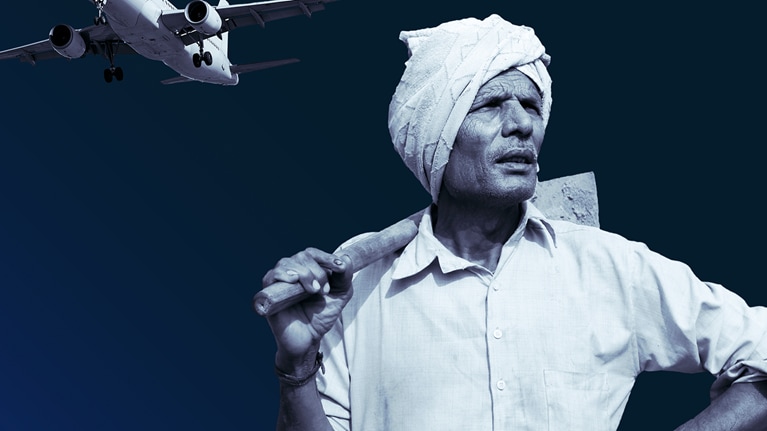
Scaling sustainable aviation fuel today for clean skies tomorrow

How airlines can chart a path to zero-carbon flying

More From Forbes
11 risks to using ai in marketing (and how to mitigate them).
- Share to Facebook
- Share to Twitter
- Share to Linkedin
While businesses across industries are implementing artificial intelligence into their processes, excited for the many benefits it may bring, these businesses must also consider the many risks it may introduce as well. From possible intellectual property and copyright violations to the loss of one’s brand voice, there are many risks to implementing AI, especially in marketing, that leaders must consider.
However, just because there are risks doesn’t mean there aren’t ways to help mitigate them. Below, 11 members of Forbes Communications Council weigh in on the risks of using generative AI in marketing, as well as share their thoughts on how to best avoid any potential problems that may come from its implementation.
1. Eventual Homogenization
AI-generated marketing pushes the need to be authentic even further into the forefront of content creation. As marketers rely more on AI to generate content, homogenization begins to occur. This is the direct opposite of the purpose of branding, which requires differentiation and authenticity as a core component. - Jen Iliff , WunderLand
2. A Lack Of Human Oversight
I think one of the main risks that can be associated with the use of generative AI is the lack of human oversight. Since AI works with data, whatever content is produced by it will be a function of how accurate and unbiased that original data is, thus requiring human criteria to ensure accuracy. On the other hand, we need to keep training AI models to think the way we would think ourselves. - Jorge Lukowski , NEORIS
3. Possible IP And Copyright Violations
The biggest risk of using generative AI in marketing is the unclear situation regarding intellectual property and copyrights. Brands should, therefore, (at least for the moment) use generative AI for research, inspiration or fine-tuning, but not blindly use AI-generated texts, images or audio content. - Rafael Schwarz , TERRITORY Influence (a Bertelsmann group company)
The Best Romantic Comedy Of The Last Year Just Hit Netflix
Apple iphone 16 unique all new design promised in new report, rudy giuliani and mark meadows indicted in arizona fake electors case, 4. a loss of individual voice.
Generative AI can help compile information, but in bringing together the many voices from the internet, it loses a marketer's individual voice. Marketers shouldn't use the information provided by generative AI as "final copy." Rather, the information needs to serve as a starting point from which a marketer can add their own unique perspective, nuance and voice. - Kathy Sucich , Dimensional Insight
Forbes Communications Council is an invitation-only community for executives in successful public relations, media strategy, creative and advertising agencies. Do I qualify?
5. Impersonal Interactions
In B2B marketing, authenticity is crucial, and AI struggles with personalization. To mitigate this issue, firms should refine AI's personalization capabilities to ensure genuine, tailored interactions—or, use a human! - Dee Blohm , Anteriad
6. Misalignments And Inaccuracies
Using generative AI in marketing poses the risk of creating content that may be inaccurate or misaligned with a brand's values, potentially damaging its reputation. To mitigate this, companies should set clear guidelines and a quality control process, invest in advanced AI tools with human oversight, and educate teams on its nuances to ensure content integrity and brand alignment. - Ronak Sheth , 360 ONE WAM Ltd.
7. Potential Bias
There is tremendous opportunity and responsibility to apply generative AI in marketing—and there are risks. The one that concerns me the most is the potential for bias. Biased data and biased models lead to biased results. To mitigate, you must have diverse training data, bias detection capabilities and a diverse team that audits generated content for fairness. Human oversight is imperative. - Jennifer Chase , SAS
8. The Creation Of Noise Over Value
One significant risk of utilizing generative AI in marketing is that it makes it much easier to make much higher volumes of slightly worse marketing content. There is so much potential with generative AI to drive efficiency and give new insights; however, many are utilizing it like the early days of email marketing: to send more emails at a scale that simply creates more noise rather than delivering value. - Jeff Marcoux , Bombora
9. A Compromised Brand Voice
One of the biggest potential risks of using generative AI is compromising the brand voice. Marketers need to ensure that the content created reflects the brand's true personality and that its uniqueness shines through. Delivering qualitative content is as important as speed. Being diligent about AI-based outcomes and keeping a check on data bias while using predictive analytics needs attention too. - Seema Kalra , The Right Thing Marketing Communications
10. A Loss Of Creativity And Originality
Marketing thrives on creativity, innovation and originality. Relying too much on generative AI runs the risk of losing these aspects and can result in uniform content. Imagine if every campaign relied on the same process; your brand's distinctiveness would fade. AI can be a helpful tool for ideation, but striking the right balance between technology and human touch is vital for an organization. - Jonathan Kaufman , Sage Dental
11. Diluted Authenticity
Excessive reliance on AI in marketing risks diluting authenticity. Mitigate by integrating human oversight, ensuring AI output meets quality standards and prioritizing genuine relationships with media and stakeholders. Both tech innovation and a human touch are key for lasting impact. - Katie Jewett , UPRAISE Marketing + Public Relations

- Editorial Standards
- Reprints & Permissions
Thank you for visiting nature.com. You are using a browser version with limited support for CSS. To obtain the best experience, we recommend you use a more up to date browser (or turn off compatibility mode in Internet Explorer). In the meantime, to ensure continued support, we are displaying the site without styles and JavaScript.
- View all journals
- Explore content
- About the journal
- Publish with us
- Sign up for alerts
- RESEARCH HIGHLIGHT
- 25 April 2024
Air-travel climate-change emissions detailed for nearly 200 nations
An inventory lists the aviation emissions of all 197 nations that are signatories to the UN Framework Convention on Climate Change. Credit: Getty
Scientists have compiled the first estimate of the amount of greenhouse gases emitted by air travel in each of the 197 countries that signed the United Nations Framework Convention on Climate Change 1 .
Access options
Access Nature and 54 other Nature Portfolio journals
Get Nature+, our best-value online-access subscription
24,99 € / 30 days
cancel any time
Subscribe to this journal
Receive 51 print issues and online access
185,98 € per year
only 3,65 € per issue
Rent or buy this article
Prices vary by article type
Prices may be subject to local taxes which are calculated during checkout
doi: https://doi.org/10.1038/d41586-024-01148-8
Klenner, J., Muri, H. & Strømman, A. H. Environ. Res. Lett. 19 , 054019 (2024).
Article Google Scholar
Download references
- Climate change

NATO is boosting AI and climate research as scientific diplomacy remains on ice
News Explainer 25 APR 24

Hello puffins, goodbye belugas: changing Arctic fjord hints at our climate future
News 25 APR 24

Ecologists: don’t lose touch with the joy of fieldwork
World View 24 APR 24
ECUST Seeking Global Talents
Join Us and Create a Bright Future Together!
Shanghai, China
East China University of Science and Technology (ECUST)
Position Recruitment of Guangzhou Medical University
Seeking talents around the world.
Guangzhou, Guangdong, China
Guangzhou Medical University
Junior Group Leader
The Imagine Institute is a leading European research centre dedicated to genetic diseases, with the primary objective to better understand and trea...
Paris, Ile-de-France (FR)
Imagine Institute
Director of the Czech Advanced Technology and Research Institute of Palacký University Olomouc
The Rector of Palacký University Olomouc announces a Call for the Position of Director of the Czech Advanced Technology and Research Institute of P...
Czech Republic (CZ)
Palacký University Olomouc
Course lecturer for INFH 5000
The HKUST(GZ) Information Hub is recruiting course lecturer for INFH 5000: Information Science and Technology: Essentials and Trends.
The Hong Kong University of Science and Technology (Guangzhou)
Sign up for the Nature Briefing newsletter — what matters in science, free to your inbox daily.
Quick links
- Explore articles by subject
- Guide to authors
- Editorial policies
Is Southwest going to start assigning seats? CEO says the airline is weighing changes.
Southwest Airlines is considering doing away with open, single-class seating on its aircraft.
In an interview with CNBC , ahead of the airline’s first-quarter earnings call on Thursday, CEO Bob Jordan said the company is weighing options for cabin reconfiguration to address its recent revenue shortfall.
“We’re looking into new initiatives, things like the way we seat and board our aircraft,” Jordan told the network.
Southwest has long differentiated itself from other airlines with one class of seating and little variability – no extra legroom seats or first class on its 737 fleet. But now, Jordan said it may be time to change the strategy.
Cruising Altitude: Another Boeing plane issue? Don't fall for the headlines.
“Customer preferences do change over time,” he told CNBC. He acknowledged the airline hasn’t made any decisions on implementing a new strategy but said studies about what they could do have yielded “interesting” results.
For now, the only reliable way for Southwest customers can get their seating preference is to pay extra for an earlier boarding position. Southwest Airlines does not currently assign seats and passengers claim their real estate as they board the plane in an assigned order.
During Thursday's earnings call, Jordan confirmed the airline was exploring updates to its seating and boarding processes. He also announced Southwest would be ending service to Syracuse, New York; George Bush Intercontinental Airport in Houston (the airline will still serve William P. Hobby Airport); Cozumel, Mexico and Bellingham, Washington. Jordan cited underperformance in those markets as the reason for their closure.
Zach Wichter is a travel reporter for USA TODAY based in New York. You can reach him at [email protected].

IMAGES
VIDEO
COMMENTS
Travel Marketing 2 operates in Italy and abroad thanks to special agreements with associated agencies for the development of strategic marketing, public relations and communication plans and it is a dynamic and innovative company dealing with the insight, creation and development of several projects for tourist international promotion for ...
Join the Travel to Marketing family. When you access the Travel To Marketing network, the world of tourism business is unlocked for you. We have selected the best DMC's for you to access a large portfolio of experiences from one place. We look after all the players within the travel industry, from tour operators to travel agents, connecting and ...
You need to take a multi-pronged approach to marketing your travel agency. Your marketing strategy should include elements like social media marketing, paid marketing, content marketing, seasonal SEO, and local SEO. These pillars will contribute to the overall strength of your marketing plan.
Whether traveling for business or leisure, going by air or train or car, the desire to travel is real. Telling your target audience how you will be providing value and keeping them safe is essential. Step #1, know your audience. Step #2, connect with them. Step #3, embrace a multi-channel strategy.
Travel Marketing 2 Srls identifies operating solutions able to optimise resources, time, financial capability in line with company's objectives. The action steps that the company will take on behalf of the client will include the different services designed to raise the client's profile, present a positive image to the media, trade, and ...
In today's highly competitive travel industry, having a robust marketing strategy is crucial to stand out from the crowd and attract potential visitors.Whether you are a destination marketing organization (DMO), travel agency, hotel, or tour operator, understanding the importance of a comprehensive travel marketing strategy is key to your success. In this article, we will explore the role of ...
4. Retarget people who have shown interest. Travel is a big purchase, and people are unlikely to make a decision the first time they land on your site. Use Facebook remarketing to target consumers who have visited specific pages on your site or have shown an interest in a specific hotel room, date, or activity.
This is easy to apply with travel booking tools like WeTravel. The right booking platform will reduce friction in the customer journey, helping you sell more tours. 3. Price. The price of your product, or tour, is arguably the most important factor in your travel marketing mix.
Travel marketing is the term given to marketing strategies that are used within the travel industry. Read the latest Marketing tips for 2024.
4. Upgrade Your Social Media Game. Social media is an integral part of any marketing strategy for 2023 and beyond. With the growing popularity of platforms like TikTok and Instagram, travel companies can leverage their social media following to increase bookings and drive traffic to other marketing channels.
2. Quality Beats Quantity. In travel marketing, blogging isn't about producing vast quantities of content; it's about creating posts that are both informative and inspirational. You're selling the dream of a fantastic vacation, and your content should reflect this vision.
The core objectives of travel marketing are to raise awareness, spark interest, and ultimately drive bookings for travel services offered by travel agencies, online travel agencies, tour operators, and travel companies. Through a meticulously crafted mix of digital marketing tactics—including social media marketing, email marketing, content ...
Here are 10 ideas to improve your travel marketing strategy using PPC this year. 1. Travel Search Stats: A 30,000-Foot View. According to Google research, 55% of leisure travelers go on just one or two trips a year. But they do a lot of research before booking those trips.
Every business on the planet needs clients. Your business needs to have goals, plans, strategies, and tactics to get those new clients. Because 100% of our focus in TRAVEL MARKETING REVOLUTION is client attraction, all you need to do is show up and trust the process. Take in the content, ask questions and implement the strategy and you WILL get ...
2. Optimizing SEO for Travel-Related Keywords. Optimizing your SEO for travel-related keywords is key for businesses looking to attract wanderlust-driven customers. As more and more travelers use search engines for trip planning, adopting a smart SEO strategy can elevate your brand's visibility, positioning it right in front of potential customers at the exact moment they're searching.
7 Effective Travel Marketing Strategies. #1 Direct Mail Marketing. #2 Content Marketing. #3 Video Marketing. #4 Influencer Marketing. #5 Email Marketing. #6 User-Generated Content. #7 Virtual Reality Marketing. 6 Best Tips for Travel Marketing Campaign.
2. Understand your audience. Within the overall market, travel agencies must clearly define their target audience. Use identifiers such as age, gender, family size, earning potential, location, etc. You can also create elaborate buyer personas to guide your digital marketing efforts. 3.
DOWNLOAD OUR FREE APP FOR THE CONTENT, COACHING, AND COMMUNITY YOU HAVE BEEN LOOKING FOR. At Travel Marketing & Media ®, we help travel brands connect with their ideal clients. We have been serving our industry for over 25 years, from travel agencies and advisors to cruise lines, tourism boards, hotels, and tour operators.
Travel Marketing 2, Rome, Italy. 846 likes · 1 talking about this. Società di Pubbliche Relazioni/Ufficio Stampa/Organizzazione di eventi nel settore del turismo
For Travel Agents: Unlock unparalleled success by partnering with Travel Trends Marketing Firm. Benefit from tailored marketing strategies, cutting-edge social media mastery classes, and a supportive community. Elevate your travel agency's brand and clientele with our expertise designed to fuel your growth.
Enroll in one of our concise courses to gain a structured and tested blueprint tailored to your business needs. Covering a wide array of topics like email marketing, social media, podcasting, Pinterest, AI, and growing your group business, our courses have been trusted and proven by over 30,000 travel agents and advisors.
Travel fell sharply during the COVID-19 pandemic—airline revenues dropped by 60 percent in 2020, and air travel and tourism are not expected to return to 2019 levels before 2024. 1 "Back to the future? Airline sector poised for change post-COVID-19," McKinsey, April 2, 2021; "What will it take to go from 'travel shock' to surge? " McKinsey, November 23, 2021.
This strategy helps create an initial boost that maintains online momentum for some time. After three to four weeks, it's crucial to observe the audience's reaction and make necessary adjustments ...
Sede legale Via Val Trompia, 140 - 00141 Roma -- Sede Operativa: Viale Aventino, 80 - 00153 Roma -- Email: [email protected] Tel: 335.8111049 - Orari: 9.00-13.00/14.00-18.00
The best B2B marketing strategies your small business should try. In-depth market research. Niche-focused perspectives. Dynamic website. On-site and off-site Search Engine Optimization. Social ...
Amit Jhawar is the CEO of Attentive, an AI marketing platform for leading brands. Previously, he was the CEO of Venmo. The iPhone revolutionized consumer behavior, reshaping the way we shop ...
9. A Compromised Brand Voice. One of the biggest potential risks of using generative AI is compromising the brand voice. Marketers need to ensure that the content created reflects the brand's true ...
Covering 36.2 million flights in 2019, their analysis provides the first detailed emissions inventory for 106 countries that do not regularly report emissions from aviation to the UN and 45 ...
0:32. Southwest Airlines is considering doing away with open, single-class seating on its aircraft. In an interview with CNBC, ahead of the airline's first-quarter earnings call on Thursday, CEO ...